
About UsThe Numismatic Bibliomania Society is a non-profit organization devoted to the study and enjoyment of numismatic literature. For more information please see our web site at coinbooks.org SubscriptionsThose wishing to become new E-Sylum subscribers (or wishing to Unsubscribe) can go to the following web page link MembershipThere is a membership application available on the web site Membership Application To join, print the application and return it with your check to the address printed on the application. Membership is only $20 to addresses in the U.S., $25 for First Class mail, and $30 elsewhere. For those without web access, write to: Terry White, Treasurer
AsylumFor Asylum mailing address changes and other membership questions, contact Terry at this email address: terrywhite5475@yahoo.com SubmissionsTo submit items for publication in The E-Sylum, just Reply to this message, or write to the Editor at this address: whomren@gmail.com BUY THE BOOK BEFORE THE COIN |
- WAYNE'S WORDS: THE E-SYLUM MAY 15, 2016
- KOLBE & FANNING HOLD WEB SALE MAY 15-16, 2016
- NEW BOOK: COINS OF THE GOLDEN HORDE
- JOHNSON ENCYCLOPEDIA MANUSCRIPT OFFER UPDATED
- BOOK REVIEW: ENCYCLOPEDIA OF COIN AND MEDAL TECHNOLOGY
- BOOK REVIEW: THE NOTORIOUS BARS OF ALASKA
- BASS NUMISMATIC INDEXES PROJECT BACK ONLINE
- NEWMAN NUMISMATIC PORTAL SCANS WINNING WAYS
- THE NUMISMATIST ADOPTS HTML VIEWING PLATFORM
- SEMI-PROOF: AN 1874 LETTER ON TRADE DOLLARS
- BUYING PROOF COINS, THEN AND NOW
- NOTES FROM E-SYLUM READERS: MAY 15, 2016
- COLLECTING NUMISMATIC AUDIO RECORDINGS
- SIGMUND BOWMAN ALEXANDER (1864-1912)
- H. A. RAMSDEN AND THE ANS
- WHO'S WHO: GEORGES DEPEYROT
- MARIA FEODOROVNA, THE DIE-CUTTING CZARINA
- MORE ON THE GOLD LIFESAVING MEDAL OF THE FIRST CLASS
- MORE ON THE VAIL MEDAL
- MEDIALIA GALLERY
- HEIDI WASTWEET'S CLEOPATRA AND ODIN DESIGNS
- DISNEY DOLLARS DISCONTINUED
- EARLY 20TH CENTURY FRENCH POSTCARD FEATURES U.S. MONEY
- U.S. POSTAL CURRENCY USED AS ACTUAL POSTAGE
- WAYNE'S NUMISMATIC DIARY: MAY 15, 2016
- COINWEEK'S MORGAN ADDRESSES 29TH MINT DIRECTORS CONFERENCE
- NRA VICE PRESIDENT SIGNS AMERICAN EAGLE HOLDERS
- OFF-METAL ERROR TWO PENCE FOUND IN CHARITY BUCKET
- BLACK MARKET PRICE OF €500 NOTE COULD RISE
- DISNEY BUSTED IN MASSIVE COUNTERFEIT SCHEME
- FEATURED WEB PAGE: PALESTINE MANDATE COINS
Click here to access the complete archive
To comment or submit articles, reply to whomren@gmail.com
WAYNE'S WORDS: THE E-SYLUM MAY 15, 2016
We have no new subscribers to report this week. Please reach out to your numismatic friends. We're always looking to add to our list of 1,971 subscribers.
This week we open with a sale from Kolbe & Fanning, an update from Dick Johnson, and two book reviews. Other topics this week include the Numismatic Indexes Project (NIP), U.S. proof coins, numismatic audio recordings, Disney Dollars, postal currency, and the black market price of the 500 Euro note.
To learn more about coin of the Golden Horde, "semi-proof" coins, Brock's Attic, the earliest American numismatic book, H. A. Ramsden, Georges Depeyrot, the die-cutting Czarina, Heidi Wastweet's Cleopatra, the World Mint Directors Conference, pliofilm flat packs, Hobo Benson tokens, extrusion dwell, and the Yokohama Numismatic Society, read on. Have a great week, everyone!
Wayne Homren
Editor, The E-Sylum
KOLBE & FANNING HOLD WEB SALE MAY 15-16, 2016

Kolbe & Fanning are holding a sale for two days on retail items listed as part of their online bookstore at numislit.com. Orders received Sunday and Monday May 15 and 16 will be 20% off, with flat-rate domestic shipping of $5 regardless of how much is ordered (foreign orders will be shipped at cost).
Our online book selection features over 1300 titles and covers the spectrum of numismatic specialties, including ancient, medieval and modern coins, medals, paper money and exonumia. We handle works from all periods and in all languages, so check us out and take advantage of our 20% off sale through the end of Monday, May 16.
The Kolbe & Fanning website can be found at numislit.com
NEW BOOK: COINS OF THE GOLDEN HORDE
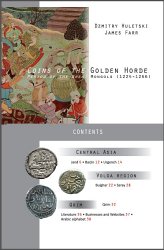 Coins of the Golden Horde
Coins of the Golden Horde
Period of the Great Mongols (1224-1266)
Catalogue
English language.
40 colour pages.
Issue limit - 100 pcs.
This book is an introduction to coinage of the Mongol Empire during its westward expansion through Central Asia, the Volga regions and the Crimea under the leadership of Chingiz (Genghis) Khan's oldest son Jochi. These lands eventually came to be ruled independently by Jochi's descendants as the Ulus Jochi, known in later times as Jochids, Jujids or the Golden Horde.
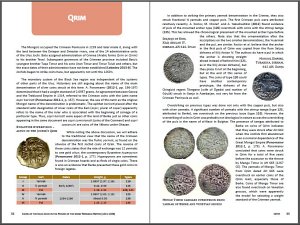 Most of the early coins of Central Asia in the book are new discoveries only recently published in the Russian literature. The authors have
attempted to relate the coinage to the historical context in which it was issued and to provide an overview of the westward expansion itself. The
Golden Horde are the Mongols who were in Russia for two centuries and who had an indelible influence on the future development of the Russian
Empire
Most of the early coins of Central Asia in the book are new discoveries only recently published in the Russian literature. The authors have
attempted to relate the coinage to the historical context in which it was issued and to provide an overview of the westward expansion itself. The
Golden Horde are the Mongols who were in Russia for two centuries and who had an indelible influence on the future development of the Russian
Empire
For more information, or to purchase, see:
http://wirecoins.de/horde1/
The book is also available on Amazon:
Coins of the Golden Horde: Period of the Great Mongols
(1224-1266) (Coinage of the Golden Horde) (Volume 1) (www.amazon.com/Coins-Golden-Horde-Mongols-1224-1266/dp/1530244366)
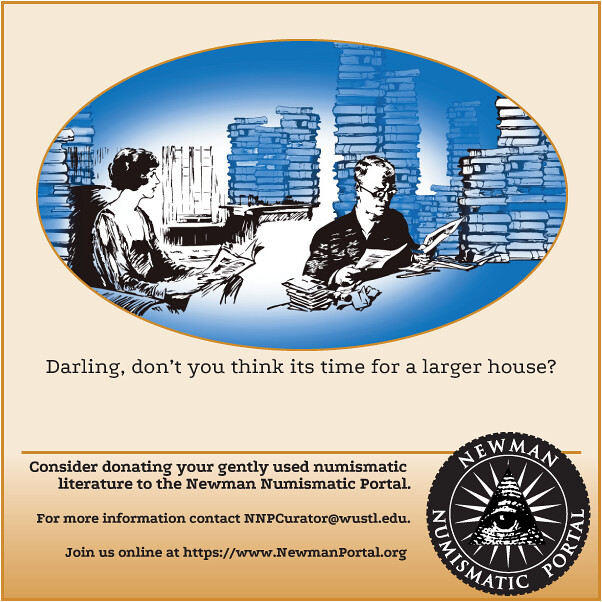
JOHNSON ENCYCLOPEDIA MANUSCRIPT OFFER UPDATED
Dick Johnson writes:
I deleted the ad for my Encyclopedia of Coin and Medal Technology from last week's E-Sylum when I learned there would be several problems in offering the preprint manuscript free for a donation of $100 or more. I had assumed it would be fun to offer such an opportunity for those interested to participate in underwriting the tremendous cost of extensive illustrations planned for the book. But lawyers seem to make things more difficult.
Instead I am offering the manuscript draft for the same $100 amount as an outright sale. I am sending paid invoices to all those who sent money.
A new ad appears in this issue. My apologies to those who sent a donation and my sincere appreciation for your early support. The end effect will be the same – all money received will be used for illustrations.
BOOK REVIEW: ENCYCLOPEDIA OF COIN AND MEDAL TECHNOLOGY
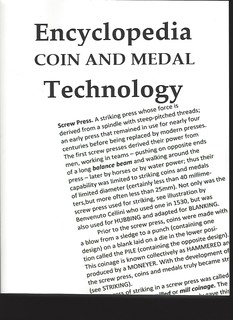 Let me get a comment in on Dick Johnson's master-work in progress. That beefy encyclopedia is 671 full size 8 1/2 x 11 inch pages long and
packed with all sorts of valuable information even a seasoned numismatist may not know. I find it fascinating.
Let me get a comment in on Dick Johnson's master-work in progress. That beefy encyclopedia is 671 full size 8 1/2 x 11 inch pages long and
packed with all sorts of valuable information even a seasoned numismatist may not know. I find it fascinating.
For example, do you know what extrusion dwell means? It means that when dies come down on a coin blank they don't just go bang, they pause for a microsecond while squeezing the planchet. That tiny fraction of a second pause, or dwell, in a coining press cycle is to prevent the metal from springing back by molecular memory. Who would have thought gold, silver and copper could do that? In simple terms, apparently all materials want to stay as they are.
I will be demonstrating this at my next talk on coins with slices of bread. When I bang my fist into a slice, most of the impression will pop back. But if I shove my knuckles into the slice and pause there a few seconds, the image on my fingers will stay on the bread.
Well, extrusion dwell is just one of the things I found fascinating in Dick's book. As someone who is writing a dictionary, I come to understand the difference between a numismatic encyclopedia and just a dictionary. In my past life as an advertising man, I was always explaining to clients that an ad or brochure needed a 5 second read and a 5 minutes read. Dick's big book does that. It starts with a clear, brief meaning of a term. If that is all you need, great. But then he gives you some interesting how and why of the device or process. And often the history about how it was developed.
Dick's decades of work in the artistic medals field shines through here. Few of us think of the difficulty involved in making a high relief medal. We learn that it takes three or four strikes with the dies to complete a medal. Each strike causes the metal to become work-hardened. So the metal must be softened by heating it in a furnace and then allowing it to cool before each strike. Sometimes an initial die is needed to get the high relief struck up, and then a die with the fine detail is used for completing the piece. I won't be looking at medals the same anymore.
The only down-side of this book is that it does not discuss paper money, only metal numismatics. It indirectly touches upon banknotes, however, as the engraver's art is explained in great detail, and that sometimes includes making intaglio plates as well as coin dies.
If you are the kind of person who enjoys saying “Wow – I had no idea that works that way” this massive book is for you. Dick Johnson sent years preparing it, you will spend weeks reading it.
Gary Beals
Segovia Spain
Author of Numiscadero the Spanish-English dictionary of Numismatics, going to press in June.
To read the earlier E-Sylum article, see:
NEW BOOK: ENCYCLOPEDIA OF COIN AND MEDAL TECHNOLOGY
(www.coinbooks.org/esylum_v19n17a05.html)
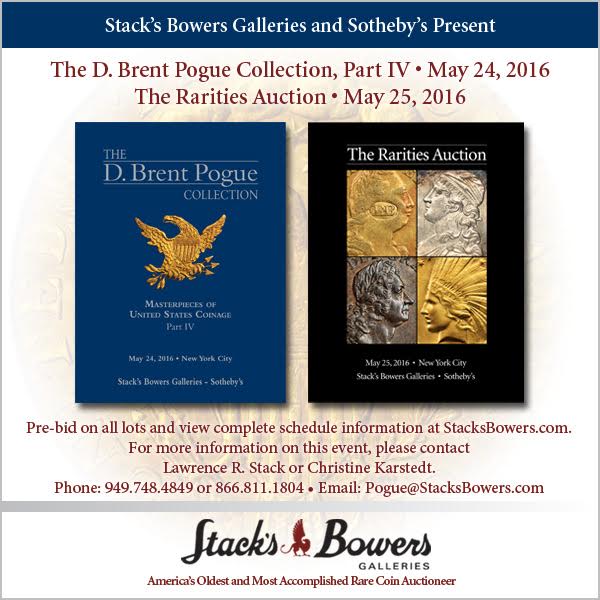
BOOK REVIEW: THE NOTORIOUS BARS OF ALASKA
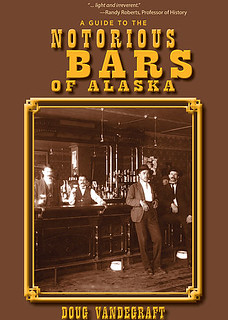 Along with coins, bullion, tokens, gold nugget jewelry and other Alaskana, we also sell Alaska books, both used and new. I was over to my
book wholesaler today, and picked up a copy of “A Guide to the Notorious Bars of Alaska” (2014, 171 pages) by Doug Vandegraft just so I could peruse
it.
Along with coins, bullion, tokens, gold nugget jewelry and other Alaskana, we also sell Alaska books, both used and new. I was over to my
book wholesaler today, and picked up a copy of “A Guide to the Notorious Bars of Alaska” (2014, 171 pages) by Doug Vandegraft just so I could peruse
it.
If you are looking for a new way to collect Alaska tokens, this just might be the text book for you. Without doing a comprehensive survey of the contents of this book, I would estimate that more than 75% of those discussed have had tokens - some old, some modern and some both. Since this is a travel guide, the bars included were still in business when the book was written.
The book is divided into geographical regions. A brief history of the bar is given, along with its license date (after prohibition). Just in Fairbanks, there is the Big I (started as the International Hotel, B-29), Mecca Bar, Midnite Mine, Comet Club, Club Manchu, Club Alaskan and Boatel Bar. All of these have modern tokens, and three can be found on page 42 of this issue of the newsletter.
The book not only hits the cities and towns, but also those highway watering holes and those in towns and villages off the road system. The author gives a great history of the Hobo Benson's Yukon Inn in Galena, “the only bar along the Yukon River from Tanana to the Bering Sea (approximately 600 miles).”
If you own any Alaska bar tokens, this book will surely add to your enjoyment. We have these available for $16.95 plus $3.05 first class postage ($20). Add $7 and I will throw in a Hobo Benson token.
For more information on the book, see:
A Guide to the Notorious Bars of Alaska (www.notoriousbarsofak.com/)
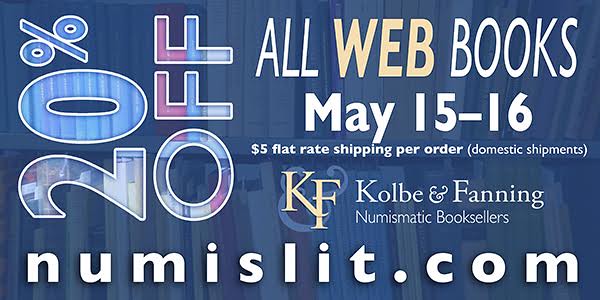
BASS NUMISMATIC INDEXES PROJECT BACK ONLINE
To access NIP from the ANA site at www.money.org, navigate the menus from DISCOVER --> LIBRARY --> HARRY W. BASS JR. INDEX. The below description was copied from the old site for an E-Sylum article in 2005. -Editor
The NIP indexes cover a wide range of numismatic scholarship over many decades from both this century and the last. From the American Numismatic Society they include:
- American Journal of Numismatics (AJN1), First Series 1866-1924
- ANS Proceedings (ANSPROC) 1878-1914
- Museum Notes (MUSNOTES) 1945-1988
- American Journal of Numismatics (AJN2), Second Series 1989-Current
- Coinage of the Americas Conference (COAC) 1984-Current
- Numismatic Notes and Monographs (NUMNOTES) 1921-1968
- Numismatic Studies (NUMSTUDIES) 1938-1993
OTHER INDEXES
In addition to those above, these periodicals are included in NIP:
- The Numismatist (ANA), 1888-Current, from the American Numismatic Association
- Numismatic Scrapbook Magazine (SCRAPBOOK), 1935-1975, from COIN WORLD
- Numismatic Review (NUMREV), 1943-1947, produced by Stack's (Numismatists)
- Coin Collector's Journal (CCJOUR#1), 1875-1888, by Scott Stamp and Coin Co.
- Coin Collector's Journal (CCJOUR#2) - New Series, 1934-1954, Wayte Raymond
- Colonial Newsletter (CNL) 1960-Current, Colonial Newsletter Foundation
- The Celator (CELATOR) 1987-1988, The Celator
To go directly to the Numismatic Indexes Project, see:
http://nip.money.org/nip/NumismaticIndexes_list.asp
To read the earlier E-Sylum articles, see:
NUMISMATIC INDEX BACK ONLINE (www.coinbooks.org/esylum_v03n29a04.html)
HARRY W. BASS, JR. FOUNDATION WEBSITE
(www.coinbooks.org/esylum_v04n27a02.html)
NUMISMATIC INDEXES PROJECT (www.coinbooks.org/esylum_v08n13a15.html)
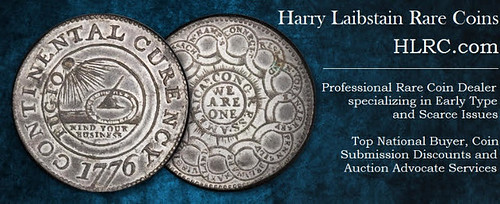
NEWMAN NUMISMATIC PORTAL SCANS WINNING WAYS
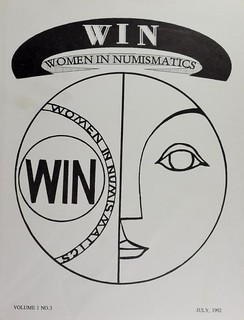 Women in Numismatics (WIN, founded in 1991) has published Winning Ways since 1992, and the issues from 1992 – 2007 are now available
on the Newman Portal. Additional issues will be posted in due course. The U.S. Mint Engraver Elizabeth Jones was an early supporter of WIN and
created the club logo, which first appeared in the third issue.
Women in Numismatics (WIN, founded in 1991) has published Winning Ways since 1992, and the issues from 1992 – 2007 are now available
on the Newman Portal. Additional issues will be posted in due course. The U.S. Mint Engraver Elizabeth Jones was an early supporter of WIN and
created the club logo, which first appeared in the third issue.
Early writers for Winning Ways included Q. David Bowers, and Ken Bressett, who held forth in The Bibliophile column. The Newman Portal acknowledges Charmy Harker, WIN President, and Dave Heinrich, Winning Ways Editor, for their assistance with this project.
Link to Winning Ways on the Newman Portal:
Winning Ways (https://nnp.wustl.edu/library/publisherdetail/511837)
THE NUMISMATIST ADOPTS HTML VIEWING PLATFORM
 The American Numismatic Association announced today that it is shifting the online viewing platform for its flagship publication,
The Numismatist, to HTML5 Viewer. The viewer is a compatibility upgrade and brings a new look and a new menu. Readers don't need any
plugins (such as Flash or other software) beyond their modern Internet browser; pages are larger and toolbars can be hidden when not in
use.
The American Numismatic Association announced today that it is shifting the online viewing platform for its flagship publication,
The Numismatist, to HTML5 Viewer. The viewer is a compatibility upgrade and brings a new look and a new menu. Readers don't need any
plugins (such as Flash or other software) beyond their modern Internet browser; pages are larger and toolbars can be hidden when not in
use.
“The new viewer is very intuitive,” says Barbara Gregory, editor-in-chief of The Numismatist. “A pop-up tutorial will guide readers the first time they access the magazine online in the new format. HTML5 Viewer should be compatible with all new platforms, including Apple iOS, which did not support the Flash plugin. Readers now will have a unified viewing experience across all browsers, regardless of the device.”
“In addition to the new look, the ANA has chosen to use HTML5 Viewer to provide an enhanced viewing experience for mobile phone users,” noted Gregory. “Articles always have been available in a text-only (“Content View”) format, but now phone browsers will default to text, while computer and tablet users will see the fully-formatted pages first.”
One of the key advantages of HTML5 is the capability of rendering multimedia content without the necessity of installing a plugin or a player application. Animation, video clips, slideshows, audio, and other multimedia tools can be embedded in Enhanced Text Articles.
To read the complete press release, see:
The Numismatist Adopts HTML for Online Viewing
Platform (www.money.org/uploads/pdfs/The%20Numismatist%20Adopts%20HTML.pdf)

SEMI-PROOF: AN 1874 LETTER ON TRADE DOLLARS
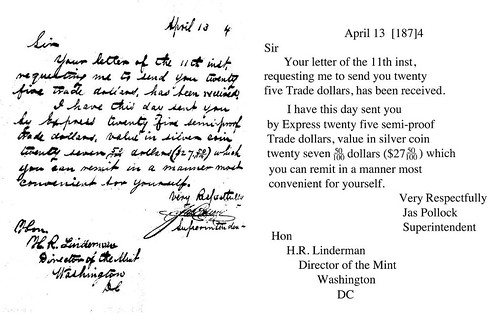
Bob Julian writes:
The attached letter will, I think, be found of general interest. The term “Semi-Proof” is new to me in the Mint records and perhaps means one of two scenarios.
1) Regular planchets struck with proof dies, or
2) Proof planchets struck with regular dies in a standard coining press.
The second option is the more likely.
It is also of interest to note that Pollock charged the director $1.10 for each Trade dollar.
BUYING PROOF COINS, THEN AND NOW
Dave Hirt writes:
I want to comment on the Proof Set boxes. The boxes were issued until some time in 1955, not stopped in 1952 as Harvey Stack stated.
I lived near Philadelphia at that time, and remember going to the mint to buy Proof Sets. The guard at the door of the mint would ask you, "what do you want"? If the answer was to buy Proof Sets, he would direct you to go up stairs, and to the right. There was a window where they sold the sets. If my memory is correct, the price per set was $2.10, and you could buy up to five sets at one time.
Dave Lange agrees. He writes:
I always enjoy reading Harvey Stack's tales of his early numismatic days, the latest being his recollection of the proof set market in the early 1950s. There was, however, one factual error that I imagine a number of readers spotted: The transition from boxed proof sets to the pliofilm flat pack occurred midway through 1955, not in 1952 as Harvey stated.
I was unfamiliar with the term 'pliofilm', so I asked Dave about it. He writes:
That was the Mint's own terminology for the variety of polyethylene used. It appears in its literature of the time.
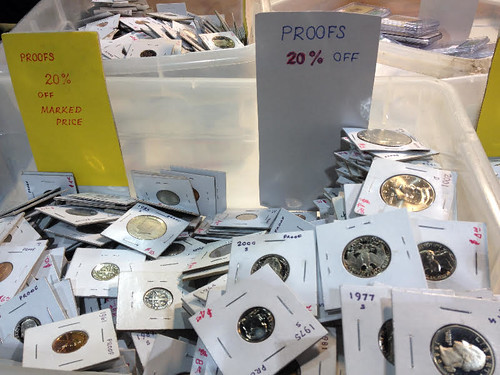
As someone who dropped out of coin collecting for some 40 years there are many numismatic surprises. I attended my first major coin show this year in Long Beach. I was startled by junk boxes with only proof coins in it.
All collectors have pawed around in dealers' junk boxes over the years, but at the Long Beach show I was surprised to see that ‘proof sets' of U.S. coins are no long so important in ‘sets.' Dealers have broken them up and put the individual coins in cardboard and mylar 2x2s and tossed them into all-proof junk boxes at their tables.
To read the earlier E-Sylum article, see:
MORE ON PRE-1955 U.S. PROOF SET SHIPPING BOXES
(www.coinbooks.org/esylum_v19n19a19.html)
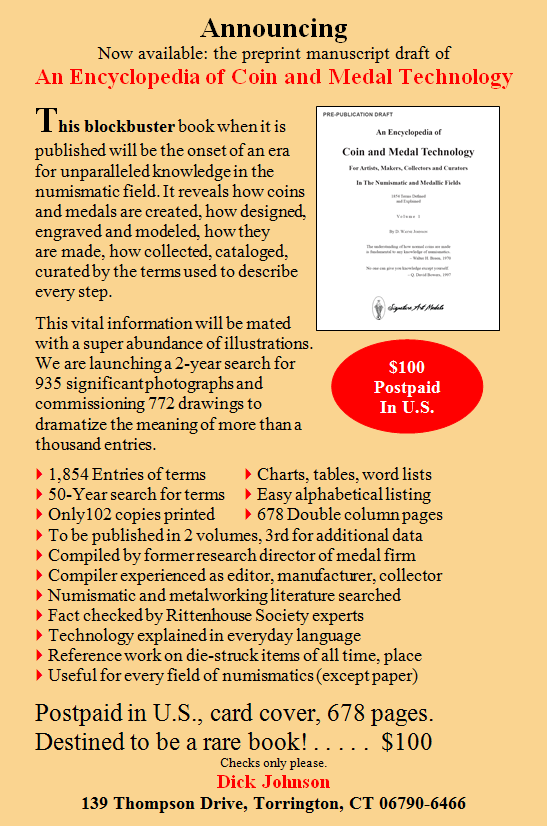
NOTES FROM E-SYLUM READERS: MAY 15, 2016
Query: How Long Was Brock's Attic Issued?
Dave Hirt writes:
I have a question for our great readers. I have two issues of a dealer's periodical, Brock's Attic Vol 1, No. 1, and No. 2, issued in 1940, and 1941, by dealer Norman H Brock. This publication is not listed in Remy Bourne's book on American Numismatic Periodicals. Does anyone know how many issues were issued?
Query: The Earliest American Numismatic Book
On another topic, Dave Hirt writes:
I finally took the time to see if I could find where W E Woodward said that R W Mercer was making fake early American items. I was not completely successful. In a 3 and 1/2 page preface to his 72nd sale, WEW states, "frauds have been perpetrated by dealers, especially in steatite and hematite; parties are now engaged in fabricating them with fraudulent intent, and in great numbers. Philadelphia and Cincinnati are most obnoxiously conspicuous". The Cincinnati reference may well be to Mercer.
Of course, during this catalog search it was easy to get sidetracked by other interesting things. I will share a couple with you. Woodward used the back cover of his 66th sale to announce the upcoming sale of the J N T Levick collection. I had thought that Levick had consigned this collection, but WEW states that he had bought the collection outright. It consisted of more than 20,000 specimens, and had a metal weight of over 500 pounds.
In Woodward's 81st sale, a book sale, lot 1548 was a book. An Inquiry into the nature and uses of money, more especially of bills of public credit, Old Tenor, to which is added a reply to the essay on Silver and Paper currencies. Boston 1740. Very rare! Attinelli does not list this book.
This book realized $4.12, a very high price for that era. I thought perhaps the buyer was William Appleton who had a large private library. However, looking through the sale of his library in 1913, I could not find it listed. Does anyone know of an earlier American numismatic book, or know of the whereabouts of this one?
To read the earlier E-Sylum article, see:
HERSHEL THOMAS DANIEL (1905-1973)
(www.coinbooks.org/esylum_v18n51a15.html)
The Museum of American Political Life
Tony Lopez writes:
I am following the controversy over the selling of the DeWitt political collection with great interest. I was an avid collector of political memorabilia and made a pilgrimage to the Museum of American Political Life at the University of Hartford in the early 1990's. While I no longer collect political buttons as actively, I still add a few pieces to my Alton B. Parker collection now and then. (Democratic Nominee defeated in 1904 against Teddy Roosevelt)
I had no idea until the news of the proposed sale of the collection that the museum had closed in 2004. It would not have surprised me to hear that the museum closed, however. The museum was obscurely located in the middle of a college campus in the basement of a building with very little signage and was difficult to locate. In the days before the internet, GPS, and Google maps, while roaming around the campus trying to find it, I wondered if I was in the wrong place. For the two hours or so that I was there, I was the only visitor, so the museum was far from being a popular destination.
As we've seen in the media reports, there is an uproar about the proposed sale of the DeWitt collection, not only from his friend and attorney Hubert J. Santos, but within the political collecting community as a whole. A lot of the frustration is being sounded out on the Facebook page of the American Political Items Collectors. A number of prominent political collectors who are well familiar with the collection and have used it for research over the years have indicated that the collection is no longer intact, and that many of the important items from the collection are now missing and may have been pilfered. At the same time, no one could identify any specific piece from the DeWitt collection which has notoriously appeared on the marketplace. As things progress, should the U.S. Attorney open an investigation, there could be more to this story.
To read the earlier E-Sylum article, see:
CONTROVERSY CLOUDS DEWITT POLITICAL COLLECTION FATE
(www.coinbooks.org/esylum_v19n19a17.html)
Wooden Money Collectors at 2016 Central States Show
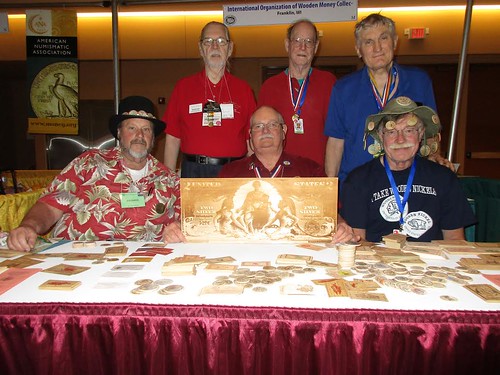
Club table @ Central States 76th Anniversary Convention
Chicago – April 2016
Back row: Harold Eckardt (IL) – Alfred Schubert (OH) – John Wilson (FL)
Front row: Bob Gabriel (NH) – Bob Fritsch (NH)– Darrell Luedtke (WI)
Photo courtesy of John & Nancy Wilson (ANA)
Applications can be obtained by emailing IOWMC@yahoo.com
Coin Board Web Site and Book Available
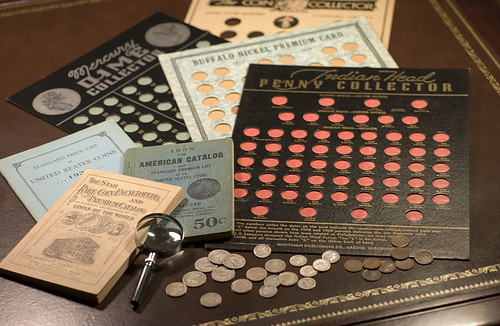
In the Summer 2016 issue of his Coin Board News, Dave Lange writes:
More than a year ago I had to take down my website CoinCollectingBoards.com, because the hosting service had declared my existing template obsolete, and its new options were ridiculously over-engineered and impossible to understand. I've found a new home with Weebly, and it was a simple matter to construct an entirely new website that's much more attractive than the last one. In coming months I'll be adding a second website for my publishing company, PennyBoard Press.
Volume Two in my series of books on coin albums arrived from the printer in early May, and copies are already shipping to buyers.
To visit Dave's Coin Collecting Board site, see:
www.coincollectingboards.com
To read a review by Paul Gilkes of Coin World, see:
David Lange relates
history of The Coin and Currency Institute's series
(www.coinworld.com/news/us-coins/2016/05/book-chronicles-coin-and-currency-institute-history.all.html)
More on Checks of King Philip II of Spain
Regarding the query from Craig Parks about financial instruments from the time of King Philip II of Spain, Robert Hoge writes:
From the time of the reign of Philip II, the only 'financial instruments' that I can think of in paper format would be 'Bills of exchange' (in Spanish, Billetes de Cambio or Letras de Cambio, and sometimes just efectos), although I have never seen or heard of one in existence from this period. Surely there must be some surviving, somewhere, since this principle had been developed in the time of the crusades, several hundred years earlier, and had been very common for a long time.
An actual numismatic paper item -- presumably NOT what your correspondents want -- would be the emergency tokens from the siege of Leyden, 1573/4, when the beleaguered citizens produced "coins" formed out of compressed pages from prayer books. These, I have seen and handled, and I should think that images of them could be fairly readily available.
I'll try to make some inquiries on your behalf with Spanish historian/archivist types and see if I can turn up anything. When one considers how important historically Bills of Exchange once were, it seems surprising how little information appears to be available about them as objects rather than as economic functions.
To read the earlier E-Sylum article, see:
QUERY: CHECKS OF KING PHILIP II OF SPAIN ERA SOUGHT
(www.coinbooks.org/esylum_v19n19a10.html)
Whittling Away at Denominations Large and Small
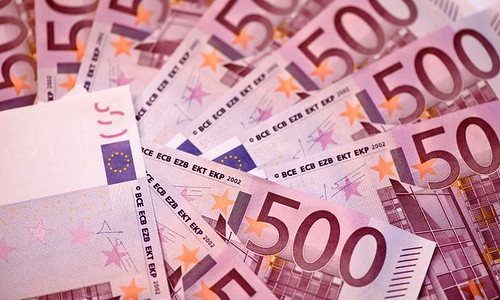
Ron Haller-Williams writes:
I have three observations on "EUROPE TO DISCONTINUE 500-EURO BILL" (and future of USA $100 bill in doubt):
(a) This is strange to me, because 50+ years ago criminals (in the UK, at least) preferred low-denomination notes because they're less remarkable, less traceable, and easier to spend.
(b) May have to change course if hyperinflation rears its ugly head
(c) On the other hand, couple this with "U.S. TREASURY CONSIDERS PLANS TO ELIMINATE CENT" and "CANADA CONSIDERS DISCONTINUING THE NICKEL" and I am wondering whether (eventually) there will be anything left in the middle!
To read the earlier E-Sylum articles, see:
EUROPE TO DISCONTINUE 500-EURO BILL (www.coinbooks.org/esylum_v19n19a29.html)
U.S. TREASURY CONSIDERS PLANS TO ELIMINATE CENT
(www.coinbooks.org/esylum_v19n19a28.html)
CANADA CONSIDERS DISCONTINUING THE NICKEL
(www.coinbooks.org/esylum_v19n19a27.html)
More on the Lincoln's Funeral Train Engraving
Regarding the eBay Lincoln Funeral Train item Philip Mernick passed along from eBay last week, 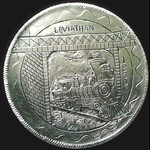 David Schenkman writes:
David Schenkman writes:
I'd bet anything that is a very modern carving.
Alan V. Weinberg writes:
That Leviathan locomotive medal is modern made and engraved. See the other items the same seller is offering- same modern engraved junk.
To read the earlier E-Sylum article, see:
NOTES FROM E-SYLUM READERS: MAY 8, 2016 : Engraving Depicts Lincoln's Funeral
Train Locomotive (www.coinbooks.org/esylum_v19n19a11.html)

COLLECTING NUMISMATIC AUDIO RECORDINGS
If it was in The E-Sylum I can't seem to find it, but I recently read an article about an old 45 rpm record on the "S.V.D.B." label with songs with numismatic titles. So guess what I just found in my garage? A copy of the record I'd forgotten I had. -Editor
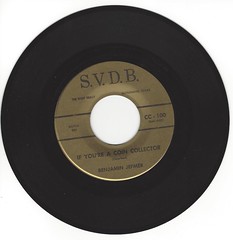
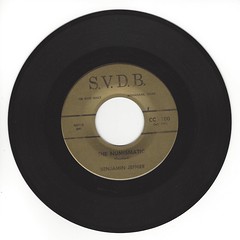
Benjamin Jefmer record
A web search turned up this review:
Benjamin Jefmer is, one could assume, a coin collector and he's written two country songs to tell us all about it. Well, okay, he only wrote one song, as both sides of this single have the exact same melody, but he at least gave them different lyrics. Both are about coin collecting, though.
At first, I looked for a metaphor in lyrics such as "Collecting has its sad times, too 'cuz it happened once to me/ I found a Lincoln extr-y fine of 1914/ But when i turned it over, what I saw, it was a shame/ Someone used a pocket knife to carve on it his name", but I found nothin'. I tried to discern a double entendre of some kind in "I started out collecting coins not many years ago/ Thought I'd put a few coins back and try to save some dough / Then one day, I bought a book/ The little folding kind / To start my set of Lincoln cents that I felt sure to find", but there is none. They're about COINS and that's that, Buster.
Also, I learned a new word from this record. "Numismatic" refers to a person who studies coins (and paper money, too). Let's all use it in a sentence today.
To read the complete article, see:
If You're a Coin
Collector / The Numismatic (http://rateyourmusic.com/release/single/benjamin_jefmer/
if_youre_a_coin_collector___the_numismatic/)
I also found these in the same container:
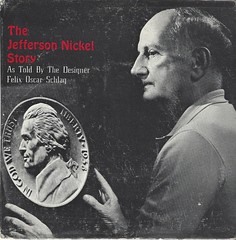

Fexlig Schlag, The Jefferson Nickel Story
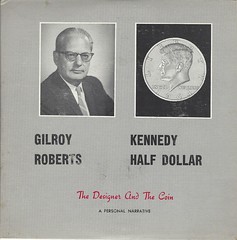
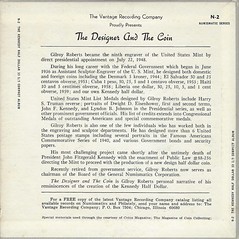
Gilroy Roberts: The Designer and The Coin
Click on an image to see a larger version in our Flickr archive. Pretty cool, huh? So would anyone have a copy of the "Vantage Recording Company catalog listing all available records on Numismatics and Philately"? As far as I know, there are the only two numismatic records the firm produced.
I wish I could say I'd listened to them, but I acquired them long after the days when record players became obsolete. I know vinyl's making a comeback, but I've got nothing in the house that can play these. The same with this:

Adelphi University Home Study Course in
Fundamentals of Rare Coin Collecting and Investing
Twenty cassette tapes with talks by Stanley Apfelbaum, Grover Criswell, John J. Ford, Jr., Harry Forman, David Ganz, William Gay, Charles Hoskins, Donald Hoppe, George Mallis, Herbert Melnick, Walter Pershke, Ed Rochette, Leroy Van Allen, and Luis Vigdor.
Great numismatic ephemera if nothing else, but the audio content of some of these is priceless.
THE BOOK BAZARRE
SIGMUND BOWMAN ALEXANDER (1864-1912)
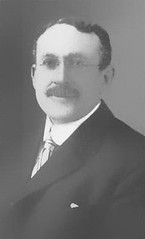 Sigmund Bowman Alexander (1864-1912), Brookline, Massachusetts. Coin dealer and principal of the firm of Alexander & Company. He was born
on March 16, 1864 at Boston, son of Jacob Alexander (1834-post 1820) and Maria Bowman Alexander (1846- post 1820). His father was a Jewish immigrant
from Germany and his mother was a native of Massachusetts. Maria Bowman was the daughter of an Englishman and a German mother.
Sigmund Bowman Alexander (1864-1912), Brookline, Massachusetts. Coin dealer and principal of the firm of Alexander & Company. He was born
on March 16, 1864 at Boston, son of Jacob Alexander (1834-post 1820) and Maria Bowman Alexander (1846- post 1820). His father was a Jewish immigrant
from Germany and his mother was a native of Massachusetts. Maria Bowman was the daughter of an Englishman and a German mother.
 He was engaged as a specie broker and insurance broker as a young man circa 1883, though his publications claims 1873 when he was just 9
years old. He dealt in United States and foreign coins, paper money and U. S. postage stamps as postal money or encased stamps in the day when Henry
Ahlborn, Ebenezer Locke Mason, Jr., and William Elliot Woodward were also dealing at Boston. Alexander began publishing coin catalogues with a neat
format about 1883 that continued until he changed the title to The Hub Coin Book in 1895.
He was engaged as a specie broker and insurance broker as a young man circa 1883, though his publications claims 1873 when he was just 9
years old. He dealt in United States and foreign coins, paper money and U. S. postage stamps as postal money or encased stamps in the day when Henry
Ahlborn, Ebenezer Locke Mason, Jr., and William Elliot Woodward were also dealing at Boston. Alexander began publishing coin catalogues with a neat
format about 1883 that continued until he changed the title to The Hub Coin Book in 1895.
He was also a writer, novelist, playwright and involved in the theatre. His first known novel was published in 1887, Ten of Us: Original Stories and Sketches. (Boston : Laughton, McDonald & Co., 1887). He wrote his second known novel in 1888, The Veiled Beyond : A Romance of the Adepts (New York : Cassell, 1888)
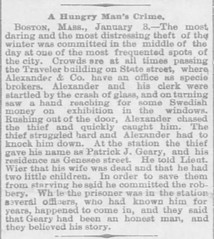 On January 3, 1888, his brokerage house was broken into by Patrick J. Geary, an unemployed widower with two starving children who grabbed
the Swedish money from the storefront window after he smashed the glass to retrieve it.
On January 3, 1888, his brokerage house was broken into by Patrick J. Geary, an unemployed widower with two starving children who grabbed
the Swedish money from the storefront window after he smashed the glass to retrieve it.
Alexander & Company met with such great success selling the United States and Foreign Coin Catalogue that they went into a
subdivision as a book publisher and bookbinder for their coin book renaming it The Hub Coin Book.
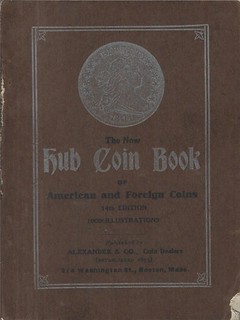
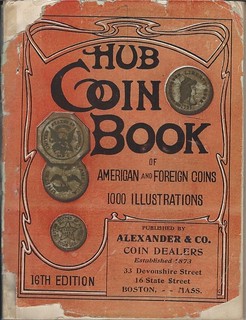
On June 8, 1896 he married at the Adath Israel Temple, Boston, to Blanch Liebmann (1871-1922) of Baltimore, Maryland, daughter of Dr. Augustus “Gustav” and Fanny Liebmann. They had a daughter Ruth Liebmann Alexander (1897-). They lived at 210 West Newton Street, Boston, Massachusetts.
He died at the age of 47 and 10 months of cerebral hemorrhage on January 5, 1912 at his in-law's home, 82 Naples Road, Brookline, Massachusetts.
The estate of Alexander managed by his wife Blanch kept publishing the Hub Coin Book and publishing it from her home state and city, Baltimore, Maryland by I. & M. Ottenheimer printers. The Hub Coin Book went into at least 34 Editions.
To read the complete article, see:
ALEXANDER, SIGMUND BOWMAN
(https://sites.google.com/a/numismaticmall.com/www/numismaticmall-com/alexander-sigmund-bowman)
H. A. RAMSDEN AND THE ANS
 There are certain numismatic personalities I expect to encounter over and over again as I work with the historical collections at the
ANS—Howland Wood, Sydney Noe, Thomas Elder, Henry Chapman. But there is a more obscure figure I sometimes find myself running into. This would be H.
A. (Henry Alexander) Ramsden, a collector and dealer who exhibited an boundless enthusiasm for his area of expertise, Far Eastern numismatics,
passionately working at it right up until his untimely death at the age of 43 in 1915.
There are certain numismatic personalities I expect to encounter over and over again as I work with the historical collections at the
ANS—Howland Wood, Sydney Noe, Thomas Elder, Henry Chapman. But there is a more obscure figure I sometimes find myself running into. This would be H.
A. (Henry Alexander) Ramsden, a collector and dealer who exhibited an boundless enthusiasm for his area of expertise, Far Eastern numismatics,
passionately working at it right up until his untimely death at the age of 43 in 1915.
Throughout the Society's library and archives are pockets of materials associated with Ramsden. There are his numerous letters in the Howland Wood, John Reilly, and Bauman Belden papers, for example. There are his publications—books, but also periodicals like The Numismatic and Philatelic Journal of Japan, which he founded and edited. Rummaging around in the library's pamphlet files recently, I happened upon what turned out to be an uncataloged item. It was ANS treasurer John Reilly's membership certificate for the Yokohama Numismatic Society, which included the stamped signature of Ramsden.
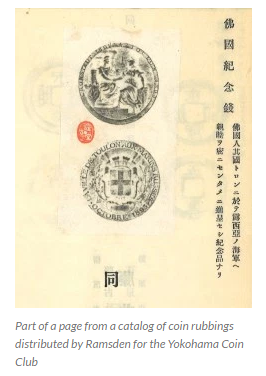 Though his influence still strongly reverberates, Ramsden remains a somewhat mysterious figure. There are no known photographs of him.
Howland Wood supplied the ANA with what little he had on him for Ramsden's obituary in the Numismatist, information Wood had gleaned from a
biographical letter Ramsden had sent him in 1914. Not too much has been added to what we know about him since. His father was a British diplomat. The
younger Ramsden followed in his father's footsteps and came to be stationed in Japan as a representative of Cuba. He married a Japanese woman and
went into business with her brother, stamp collector and dealer Jun Kobayahawa, in Yokohama.
Though his influence still strongly reverberates, Ramsden remains a somewhat mysterious figure. There are no known photographs of him.
Howland Wood supplied the ANA with what little he had on him for Ramsden's obituary in the Numismatist, information Wood had gleaned from a
biographical letter Ramsden had sent him in 1914. Not too much has been added to what we know about him since. His father was a British diplomat. The
younger Ramsden followed in his father's footsteps and came to be stationed in Japan as a representative of Cuba. He married a Japanese woman and
went into business with her brother, stamp collector and dealer Jun Kobayahawa, in Yokohama.
He built up an enormous numismatic collection, over 15,000 specimens, including Chinese, Japanese, and Korean coins, as well as an impressive library. His unexpected death threw the future of these collections into question, and after some back and forth with the executor of his will, they were purchased by Reilly, who retained ownership, though they were housed at the ANS. Reilly's daughter Frances formally donated the materials in 1938.
To read the complete article, see:
LESSER KNOWN COLLECTOR AND
DEALER H. A. RAMSDEN LEFT HIS MARK AT THE ANS
(www.anspocketchange.org/lesser-known-collector-and-dealer-h-a-ramsden-left-his-mark-at-the-ans/)

WHO'S WHO: GEORGES DEPEYROT
 Georges Depeyrot
Georges Depeyrot
Professor and Director of Research at the Paris CNRS as well as the École Normale Supérieure Author, publisher and editor of numismatic
literature
Georges Depeyrot (*1953) studied History to become a teacher at the University of Toulouse II (licence since 1974) and, after obtaining two further degrees in Toulouse (Maîtrise des Lettres in 1975, DEA in 1976), received his doctorate degree in Toulouse II in 1977. After a temporary job at the Ministry for Culture (until 1981), he began teaching Ancient Numismatics at the University of Toulouse in 1982. From 1982 to 1985, he worked at the “Centre numismatique E. Babelon” in Orléans and, from 1986 to 1989, contributed to a research project on Medieval economy in Lille (“Économie médiévale, l‘espace européen”). Between 1989 and 2010, he worked at the “Centre de recherches historiques” in Paris. In 1992, he qualified as a professor at the University of Besançon, before obtaining another licence to teach at universities in 1993. From 1994 to 1997, he taught at the École des Hautes Études en Sciences Sociales as Adjunct Professor. Between 1998 and 1999, he taught, as a lecturer, in Paris.
Concurrently with this, he started working in the publishing sector: between 1994 and 2000, he supervised the series “Collections numismatiques” of the publishing company Errance-Actes Sud. In 1995, he founded the Moneta series (Wetteren) over which he presides down to the present day.
Since 2010, he is a member of the research unit “Archaeology and Philology of East and West” at the École Normale Supérieure in Paris. Since 2012, he is Director of Research, 2nd Class, at the national research center CNRS.
Georges Depeyrot spent research periods abroad, for example in the U.S., and taught in Japan as Visiting Lecturer for a total of two years, between 2011 and 2015. He is honorary member of a number of numismatic societies, not only in Romania and Albania.
He engages in numismatic expert committees on a regular basis and functions as supervisor.
He has an impressive list of publications (currently comprising more than 500 individual articles and about 180 monographs and volumes of essays to which he contributed as an author and co-editor); thematically, his publications cover the entire range of numismatics and monetary history.
To read the complete article, see:
Numismatic Who's Who: Georges Depeyrot
(www.coinsweekly.com/en/Numismatic-Whos-Who/Georges-Depeyrot/42?&id=24)
THE BOOK BAZARRE
MARIA FEODOROVNA, THE DIE-CUTTING CZARINA
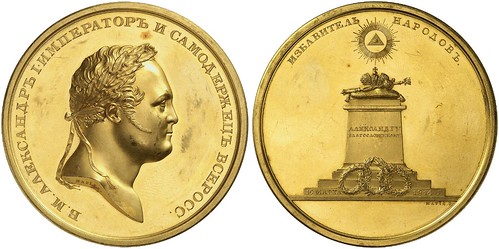
From Künker Auction 277, Lot 345: Gold medal in the weight of 48 ducats of Maria Feodorovna on her son's entry in Paris. This specimen, coming up at the next Künker summer-auction, is estimated at 125,000 euros.
The medal of Czar Alexander I, honoring him as “savior of the people”, and issued in three metals – gold, silver, bronze – is stunning. On the reverse it shows an altar, on which the Russian insignia, crown, scepter, and imperial orb are placed. Above all, the Eye of Providence in the aureola is glancing down. The inscription “To Alexander the blessed” is engraved into the front of the altar. Three wreaths are lying at the base of the altar sacrificed to the heroic czar: in the middle there is the laurel wreath of the victor, to the left the wreath of peace made of olive branches, and to the right an oak wreath for saving people's lives. The date on the medal, March 19th, 1814, doesn't correspond to the year of issue of the medal. It refers to the glorious entry of the victorious Allies in Paris. But do not wonder, why this historical event, according to the medal, took place on March 31st – keep in mind that the Russians at the time followed the Julian calendar. And Maria Feodorovna, whose name is inscribed below the floor line of the altar, thought Russian, even though she was born in Germany in 1759.
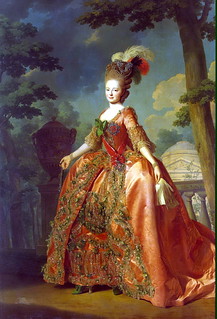 Sophie Dorothea, as her baptized name was, was the fourth of the twelve children of Frederick Eugene of Württemberg, who later, a long time
after her marriage, became Duke of Württemberg. Her mother was the grand daughter of a sister of Frederick the Great, which is why Frederick used an
enquiry of the Russian Czarina Catherine to marry his great grand nice off to Paul, heir to the Russian throne, and therewith getting Prussia closer
to Russia. For this, Sophie Dorothea had to convert to the orthodox faith and take on the name Maria.
Sophie Dorothea, as her baptized name was, was the fourth of the twelve children of Frederick Eugene of Württemberg, who later, a long time
after her marriage, became Duke of Württemberg. Her mother was the grand daughter of a sister of Frederick the Great, which is why Frederick used an
enquiry of the Russian Czarina Catherine to marry his great grand nice off to Paul, heir to the Russian throne, and therewith getting Prussia closer
to Russia. For this, Sophie Dorothea had to convert to the orthodox faith and take on the name Maria.
Maria devoted herself to her artistic inclinations. She played the harpsichord, sang and painted watercolors – just like most of the well-behaved young ladies. Quite unusual was her profound interest in engraving. She designed cameos, worked herself with carving knifes to create works in ivory, and at an unknown point in her life she learned the craft of a medalist. In Nagler's History of Arts we can read that Carl von Leberecht, who served at the Russian mint as a medalist since 1776, bragged that “an Empress was under his pupils, that is the Empress Mother Maria Feodorovna.”
While soviet historians could not imagine (or weren't allowed to) that a Czarina was able to do something meaningful, today's historians assume that Maria Feodorowna did have the skills to design medal dies. And we do know about a work shop, which she installed in her later years in Pavlovsk. It is there, where the “steel matrices displaying emblems of mythology” and “different coining dies” were stored.
Maria Feodorovna certainly did have enough time to learn a craft during her long years in Gatchina, when Paul and her were reduced to doing nothing. And in the 18th century it wasn't that unusual for a member of high nobility to be a craftsman in his leisure time. The opera Czar and Carpenter, for example, is based on the fact, that Peter trained as a carpenter. Louis XV of France worked the wood lathe, and Louis XVI worked as a black smith in the royal smithy. And they were not the only ones. So, Maria Feodorovna chose to spend her time learning to cut stones and dies, which is why she went into training with Carl von Leberecht.

From Künker Auction 277, Lot 346: Bronze medal of Maria Feodorovna on her son's entry in Paris. The estimate of this piece only amounts to 500 euros.
Of course, a Czarina did not create coin dies for every day strikings. But, as a German and mother, the victory of her son Alexander I over Napoleon was worthy for creating dies with her own hands displaying this success. We know of two different die pairs for this medal, whose designs deviate slightly.
When she was named full and honorary member of the Prussian Academy of Arts in the presence of the Prussian King Frederick William III on December 26th, 1818, she subsequently – as required in the bylaws of the Academy – provided an entrance piece. And this piece was the medal, which she created to honor her son's victorious entry in Paris.
Maria Feodorovna died on November 5th, 1828 in Pavlovsk. Just shortly before her death, she was able to read about herself, the “skillful princess”, in Nagler's Encyclopedia of Artists.
To read the complete article, see:
The die cutting czarina
(www.kuenker.de/en/information/presseinformationen/aktuelle-mitteilungen/78)

MORE ON THE GOLD LIFESAVING MEDAL OF THE FIRST CLASS
Jonathan Brecher, Alan Weinberg and Tony Lopez responded. The most comprehensive comments came from Tony and these appear next. I've included new images provided by David. Thanks, everyone! -Editor
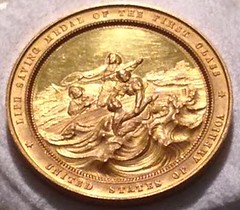 Garrett H. White, the recipient of the gold Lifesaving medal was a Coast Guard “Surfman” and one of six recipients awarded the gold
Lifesaving medal by the Treasury Department on June 18, 1880 for the February 3, 1880 rescue of the crew of the schooner E.C. Babcock and crew of the
Spanish Brig Augustina during a vicious storm off Monmouth Point, NJ. During the rescue, Garrett's actions were particularly gallant as he rushed
into the dangerous surf to untangle and rescue men on the line attached to the Augustina.
Garrett H. White, the recipient of the gold Lifesaving medal was a Coast Guard “Surfman” and one of six recipients awarded the gold
Lifesaving medal by the Treasury Department on June 18, 1880 for the February 3, 1880 rescue of the crew of the schooner E.C. Babcock and crew of the
Spanish Brig Augustina during a vicious storm off Monmouth Point, NJ. During the rescue, Garrett's actions were particularly gallant as he rushed
into the dangerous surf to untangle and rescue men on the line attached to the Augustina.
The other recipients during the rescue were:
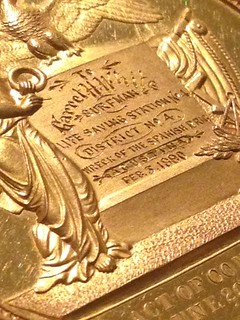 Charles H. Valentine
Charles H. Valentine
Nelson Lockwood
Benjamin C. Potter
William H. Ferguson
John Van Brunt
The details of the rescue can be found online: http://www.uscg.mil/history/awards/GoldLSM/
3_Feb_1880_2.asp
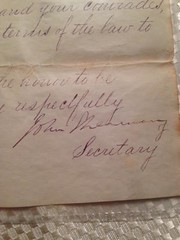 John Sherman was the Secretary of the Treasury under Rutherford B. Hayes from 1877-1881. The 6-page handwritten letter from the Treasury
Department which accompanied the medal is secretarial and not in the handwriting of John Sherman. Only the first page of the letter was pictured in
the article, so it is uncertain whether Sherman personally signed the letter, or if it was also done secretarially. [I've added an image of the
signature. -Editor]
John Sherman was the Secretary of the Treasury under Rutherford B. Hayes from 1877-1881. The 6-page handwritten letter from the Treasury
Department which accompanied the medal is secretarial and not in the handwriting of John Sherman. Only the first page of the letter was pictured in
the article, so it is uncertain whether Sherman personally signed the letter, or if it was also done secretarially. [I've added an image of the
signature. -Editor]
During the storm on February 3, 1880, the Treasury Department awarded a total of 26 gold First-Class Lifesaving medals for two separate rescue events. Other than the six gold medals awarded for the rescue of the E. C. Babcock and Augustina off Monmouth Point, NJ, another 20 gold medals were awarded for the rescue of the schooner George Taulane off Swan Point, NJ that same day. Had Sherman written all 26 of the accompanying six-page award letters to the recipients personally, he would have needed to handwrite a total of 156 pages – which explains why he assigned this responsibility to others.
The gold Treasury Department Lifesaving medal awarded to Garrett H. White in 1880 is listed in Robert Julian's Medals of the United States Mint, The First Century 1792-1892, catalogued as “Julian LS-7”. In 1877, the Treasury Department reduced the size of the 1874 First-Class medal. The 1877-1882 LS-7 medal has the same designs both obverse and reverse as the earlier 1874 medal (Julian LS-5), but the size was reduced from 76 mm to 50 mm in diameter as seen with this medal. The most significant difference was the gold content which was reduced in 1877 from approximately 11 troy oz. to only 3 troy oz. In 1883, the First-Class medal was again reduced in size – to 44mm – but continued to maintain the same design.
The records in the Julian Mintage Records Appendix are as follows:
- 1876/1877 29 gold
- 1877/1878 7 gold, 5 copper (copper likely for collector purposes)
- 1878/1879 8 gold
- 1879/1880 14 gold
- 1880/1881 27 gold (26 of them for rescues during the February 3, 1880 storm off New Jersey)
- 1881/1882 3 gold, 2 White Metal
- 1882/1883 4 gold (Likely LS-9medals)
It is impossible to tell from the US Mint records in the Appendix of Julian the exact number of the larger LS-5 vs. smaller LS-7 medals struck. The first of the smaller medals were struck in mid-February 1877, and the records for this period begin with fiscal year 1876/1877, so it is unknown how many of the 29 medals struck within this timeframe were of the smaller LS-7 50 mm size.
The gold and white-metal medals struck during fiscal year 1881/1882 seem to contradict Julian's statement in the description of the medal that none of the 50 mm LS-7 medals were struck after 1880. The first of the smaller 44 mm LS-9 medals were struck beginning on June 16, 1883. The striking of these medals in 1883 falls within the fiscal year 1882/1883, so it is likely all 4 of the medals recorded were indeed the smaller LS-9 medals. Extrapolating from the records compiled in Julian, no more than 88, and no less than 56 of the gold 50 mm LS-7 medals of the type awarded to Garrett H. White were struck. In the 1986 Price Guide supplement to the Julian US Mint medal reference, Richard Hartzog lists a mintage of 88 LS-7 medals struck in gold.
The United States Coast Guard records show that there were a total of 37 recipients of the First-Class Lifesaving Awards between October 10, 1877 and February 4, 1881. The remainder of the gold medals issued were likely awarded outside of these Coast Guard records, and a few of the gold medals may have been struck for collectors.
One of the two rare white-metal examples of LS-7 (not engraved and thus unawarded) sold in the June 2004 Stack's sale of the Medio/Da Costa Gomez Collection, Lot 2782, realizing $489.00.
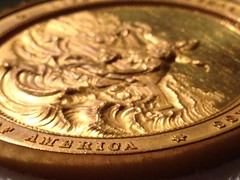
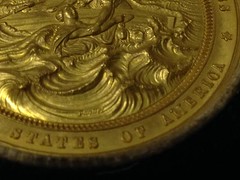
Close-ups of the high relief and Paquet's mark
Alan Weinberg adds:
This one is special due to the apparent pristine condition, pristine original case and documents accompanying it. It is superior to the cased specimen I recently acquired.
Jonathan Brecher located some information on the larger L-5 medal from the Norweb collection, which still makes for good reading. -Editor
On the larger LS-5 version
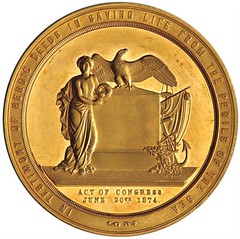 Jonathan Brecher writes:
Jonathan Brecher writes:
LS-5 is one of the scarcer medals in the Lifesaving series, in any composition. I have only one auction record for a gold example, sold by Stack's in 2006. The extensive writeup in that lot description is probably the best source of information that you can get… although it appears that this specimen is _not_ one of the three awarded examples described in that listing.
To read the complete lot description for the gold LS-7 medal, see:
Lot# 2256: 1876 Treasury Department Lifesaving medal, first
class. Julian LM-5. Choice Mint State. (http://prior.stacks.com/lotdetail.aspx?lsid=AN00000584&lotno=2256)
Regarding the John J. Ford collection, Alan Weinberg writes:
Ford did NOT own a large size gold. He likely handled and sold them as they represented too much money tied up in gold value and weren't that rare. Ford was often cash-poor and had to sell to raise $ to buy something as his collecting interests were so broad and all-encompassing.
On the smaller LS-9 version
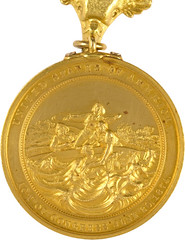 Alan Weinberg writes:
Alan Weinberg writes:
There is a smaller size that is suspended from a ribbon and hanger...exact same design. Stack's somewhat regularly auctions the smaller size in gold. One was in the recent Baltimore Stack's Bowers auction after it didn't sell last year. It sold for around $4K. The small size gold is so easily acquired that I never wanted one.
To read the complete lot description, see: U. S. Mint Medal: Treasury Department, Gold Life Saving Medal, First Class (http://historical.ha.com/itm/political/u-s-mint-medal-treasury-department-gold-life-saving-medal-first-class/a/6086-38334.s)
To read the earlier E-Sylum article, see:
GOLD LIFESAVING MEDAL OF THE FIRST CLASS
(www.coinbooks.org/esylum_v19n19a13.html)
THE BOOK BAZARRE
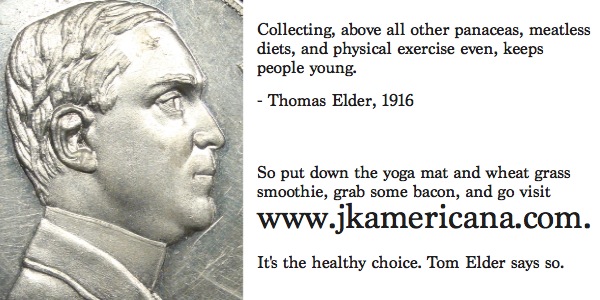
MORE ON THE VAIL MEDAL
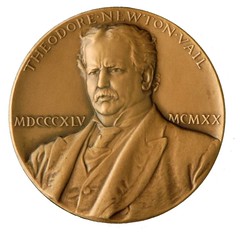

Shades of Walking Liberty Graced With Truth and Heroism
By Ted Lierl
Pictured in this article is a Vail Medal for Noteworthy Public Service that was awarded to Truth H. Jensen for her efforts to save lives threatened by fire in 1955.
The reverse contains the monogram of its designer Adolf Alexander Weinman, more widely known to numismatists for his beautiful coins, the Walking Liberty Half Dollar and the Mercury Dime.
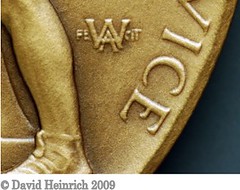 Weinman, one of the leading sculptors in the United States, designed the Vail Medal in 1921. In designing the medal, Mr. Weinman captured
not only the personality of Vail, but also his ideals of service to the public.
Weinman, one of the leading sculptors in the United States, designed the Vail Medal in 1921. In designing the medal, Mr. Weinman captured
not only the personality of Vail, but also his ideals of service to the public.
The pictured Vail Medal was struck in bronze by the Medallic Art Company of New York and is 63millimeters (about 2.5 inches) in diameter. It is marked “1425-1955” on the edge.
Bronze medals were awarded to individuals in each Bell System company, by that company's awards committee. A bronze medal was sometimes awarded to groups of employees where the noteworthy act was due to the concerted action of the group, rather than by an individual.
A bronze plaque commemorating the act was presented to the company concerned. These plaques were designed for display in telephone buildings as a permanent and public memorial. Plaques may be seen to this day in telephone company buildings across the nation.
Up to the breakup of the Bell System in 1984, hundreds of Vail Medal awards were made to telephone company employees for acts of public service and bravery ranging from struggling through a blizzard to fixing a downed line; saving a child from a burning building or a man from a raging flood; to staying at the switchboard while bullets flew.
The blue leather Vail Medal presentation box for Truth Jensen's Medal contained a brochure that detailed the history of the Vail Medal for Noteworthy Public Service as follows:
“The Vail Medal, established in 1920 under the terms of the Theodore N. Vail Memorial Fund, is awarded for acts of noteworthy public service which reflect the Bell System's highest traditions of loyalty and devotion to duty.”
The face of the Medal bears the likeness of Mr. Vail, President of the American Telephone and Telegraph Company from 1907 to 1919, in whose memory the award was established. Struck in gold, silver, or bronze, the Medal symbolizes and perpetuates his ideals of service to the public.
The dominant central figure on the reverse of the medal represents the “Civilizing Force of Communication” speeding the winged message along the wires. At the right, “Loyalty to Service” upholds the left hand of the central figure, while a third figure, “Devotion to Duty”, helps support the lines of communication at the left of the group. “
Upon email contact, the seller provided the following additional background information:
“Truth was my great aunt. She was a telephone operator here in Portland, Oregon from the late 40's to the mid 60's. From what my Mom can remember Truth stayed calm receiving calls from a major apartment fire, thought quick, gave sound advice and was credited with saving lives.
All in all, this particular medal has great eye appeal, a gifted designer, and a heart-warming story of an everyday hero.
Editor's note; Ted Lierl passed away on July 6th 2015. Ted always brought fun with him when he came to our meetings, his joy of collecting overflowed into others around him. Ted had a talent for writing and was a good man, I can't emphasize those last three words enough, a good man!
This article is reprinted in memory of Ted. It was originally published in the May 2009 issue of The Cincinnati Numismatist. It is one of three articles that Ted wrote for our newsletter.
For more information on the Cincinnati Numismatic Association, see:
CINCINNATI NUMISMATIC ASSOCIATION (https://cincycoinclub.org/)
To read the earlier E-Sylum articles, see:
1925 THEODORE N. VAIL MEMORIAL MEDAL (www.coinbooks.org/esylum_v17n25a10.html)
THEODORE N. VAIL NATIONAL AWARD MEDALS
(www.coinbooks.org/esylum_v17n26a13.html)

MEDIALIA GALLERY
Joe writes:
The site is http://medialiagallery.com/ If you click “Artists,” you will find an extensive list of medalists and sculptors, including prices for the works that they carry. Check out, for example, Ron Dutton, who received the ANS's Saltus Award in 2008. Really neat work.
Ron Dutton
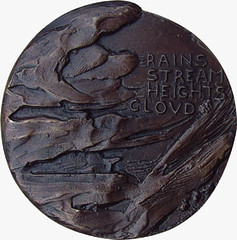
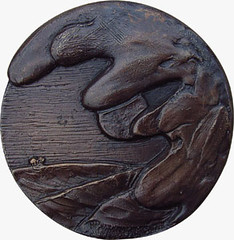
Rain Stream, 1982
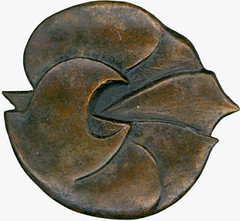
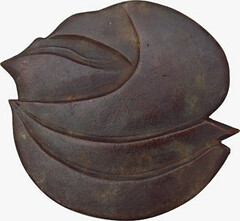
Spring Twitter, 2008
Leonda Finke
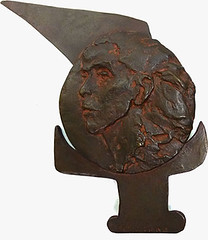
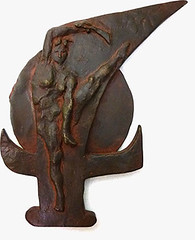
MARTHA GRAHAM • CLYTEMNESTRA, 1982
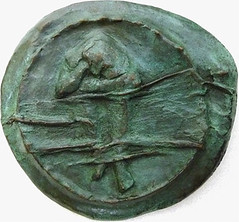

RAPE • COMPANION OF WAR, 1993
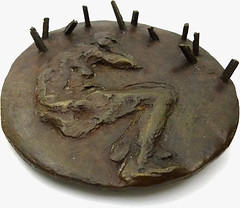
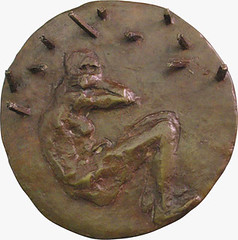
SURVIVORS, 1987
To visit the Medialia Gallery web site, see:
http://medialiagallery.com/
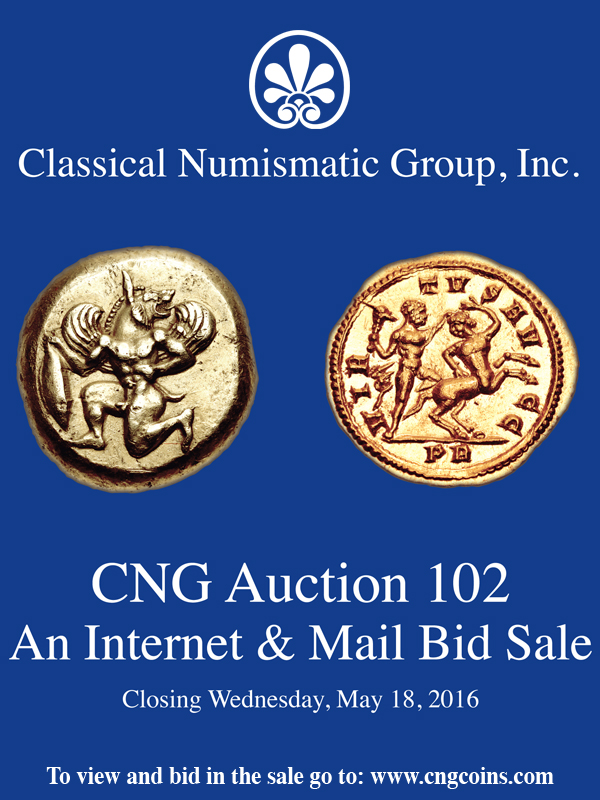
HEIDI WASTWEET'S CLEOPATRA AND ODIN DESIGNS
Cleopatra
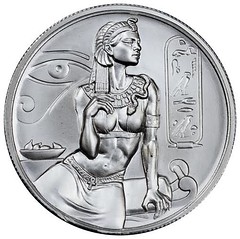
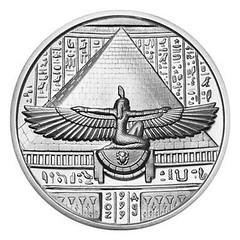
From the Provident Mint web site:
Celebrating one of history's most captivating rulers, the Cleopatra High Relief Silver Round is composed of 2 troy oz of .999 fine silver — eligible for contribution in your self-directed IRA.
Crafted by the Elemetal Mint using the highest production and metal-purity standards in the industry, the Cleopatra Silver Round sets a new standard in bullion quality. Order yours today.
The obverse of each Cleopatra Silver Round is sculpted in the incused style of ancient Egyptian hieroglyphic carvings. Rising from the surface of the round, Cleopatra comes to life through subtle movement, indicated by the space intentionally left void behind her neck. Because her face is not incused, she appears to be moving forward.
To her right is the cartouche of Cleopatra — a vertical oval featuring a horizontal line at the bottom, signifying that the inner text was a name of royal lineage.
To the left of Cleopatra sits the Eye of Horus, sculpted by the incredibly talented Heidi Wastweet, using a groundbreaking technique never before seen on a precious metal bullion round. This Ultra High Relief element features varying heights and depths, both incuse and raised above the field.
Below the Eye of Horus sits a bowl of figs, which Cleopatra's servants used to smuggle in a poisonous snake called an asp, which slithers down her shoulder and neck. It is widely believed that Cleopatra committed suicide through the lethal bite of an asp. The tragic scene was immortalized by William Shakespeare in Act V, Scene II of Antony & Cleopatra:
With thy sharp teeth this knot intrinsic
Of life at once untie: poor venomous fool
Be angry, and dispatch.
The reverse of each Cleopatra 2 oz Ultra High Relief Silver Round features the Goddess Isis — of whom Cleopatra was said to be the reincarnation — situated prominently at the center. The banner of the scarab beetle rests below. The scarab beetle was a symbol of great power in ancient Egyptian mythology, responsible for pushing the sun into the sky at dawn.
The Hieroglyphics on the field were taken from ancient Egyptian papyri, featuring writings about Cleopatra. The pattern to the left and right of the weight-and-purity hallmark can be found on the outer wall of the Temple of Horus. They represent a bed of lotus reeds blooming in the Nile.
Heidi adds:
The second in this series, Anubis, is in production now.
For more information, or to order, see: Cleopatra 2 oz Ultra High Relief Silver Round (www.providentmetals.com/cleopatra-2-oz-high-relief-silver-round.html)
Odin
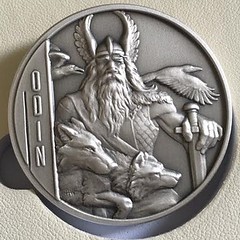
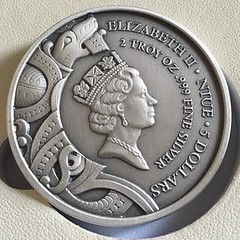
From the Gainesville Coins web site:
-
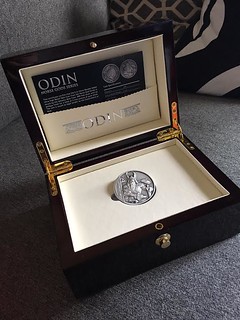 Double-Sided Ultra High Relief (Obverse & Reverse!) Mintage Of Only 750 Coins
Double-Sided Ultra High Relief (Obverse & Reverse!) Mintage Of Only 750 Coins
- 2 oz Of .999 Pure Silver with an Antique Finish
- 1st Release In 4-Coin Series | $5 Legal Tender
- Produced In Switzerland At The Helvetic Mint
- Designed By Famed Artist Heidi Wastweet
- Includes Stunning Wooden Box And COA
In many Nordic and Germanic traditions, Odin is the steward of the underworld, Valhalla, and is often accompanied by his two ravens and a pair of wolves. He is a central figure throughout Norse mythology. Even the day of the week “Wednesday” is his namesake in several languages, from Woden in Old English and Wodan in Old German.
Powerful, wise, and venerated, Odin is now featured on the first of the limited-mintage 4-coin Norse Gods series. Each legal tender coin is struck from .999 fine silver. Subsequent issues in the series will include other prominent deities from the Norse tradition, such as Thor and Loki.
For more information, or to order, see: 2 OZ DOUBLE-SIDED ULTRA HIGH RELIEF ODIN SILVER COIN (www.gainesvillecoins.com/featured/odin-silver-coin)
Heidi adds:
Humorously, there is an unusual amount of high relief Odin coins that were released in the last year, all unrelated to each other. Must be something in the water. I have just begun work on the second in this series, which is Thor.
To read the complete article, see:
WAYNE'S NUMISMATIC DIARY: MARCH 20, 2016
(www.coinbooks.org/esylum_v19n12a26.html)
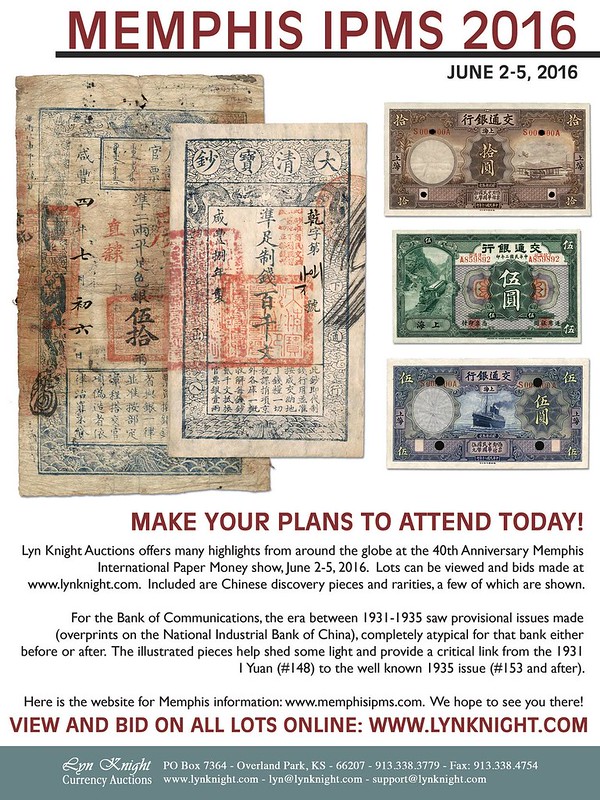
DISNEY DOLLARS DISCONTINUED
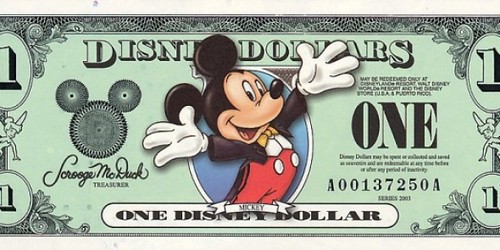
Disney Dollars, a popular souvenir item and an in-house currency at Disney parks, will no longer be sold.
A Disneyland statement confirmed on Thursday the once popular currency, which could only be used at Disneyland and Walt Disney World, would be terminated effective Saturday.
The Disney Dollars currently in circulation can still be used.
“It's a testimony to the enthusiasm and heart of Disney guests and collectors that Disney Dollars remain collectible today,” the Disneyland statement said. “We continue to offer many ways to collect cherished Disney memories in tangible ways.”
Gift cards and other forms of payment made the Disney Dollars obsolete.
Disneyland's first president, Jack Lindquist, invented Disney Dollars because of the Anaheim and Orlando theme park's growing popularity in the mid-1980s. The first runs were unveiled and circulated on May 5, 1987.
“We set the criteria that our Disney money would always be tied to the price of the U.S. currency, so if a dollar is worth a dollar, a Disney Dollar would be worth a U.S. dollar,” Lindquist said in his memoir, “In Service to the Mouse.” “That way, the money could be spent in the parks, the same way U.S. currency is.”
Disney Dollars featured pictures of Mickey Mouse, Donald Duck and other characters. They were sold at the theme parks in denominations of $1, $5, $10, $20 and $50.
Disney Dollars were produced with the same level of security, “care and concern as any other currency,” Lindquist said.
Montica writes:
Disney is losing some magic with this decision. I hate to see what happens next. They will guickly become an everyday business if these decisions continue. It's the little things that make the magic real.
Joe P. writes:
They haven't promoted them in a long time. They used to display them at the ticket booths and in the guide maps. I haven't seen them since they went to the new ticket booths when DCA opened.
Elizabeth writes:
Wow! I guess the world is ending! Disney is discontinuing Disney dollars. I didn't know they still made them! Gheese people, really? The magic is gone! I guess we should all just stop going!
Sher writes:
It would have been nice to have more notice than 2 days. Disney should have made that announcement earlier. I found out on May 12th and went to WDW on May 13th at 2:00 and City Hall was already sold out and so was the GF and Contemporary, but got to the Polynesian and David at the front desk said he only had 7 five dollar bills left. If I had known before hand I would have bought more. A 2 days notice of something being discontinued isn't enough time. These make great Christmas/Birthday gifts to our family and friends. Sad, they won't be getting them from us anymore.
To read the complete article, see:
BREAKING: Disney Dollars to be
Discontinued May 14th, 2016 (http://wdwnt.com/blog/2016/05/breaking-disney-dollars-to-be-discontinued-may-14th-2016/)
EARLY 20TH CENTURY FRENCH POSTCARD FEATURES U.S. MONEY
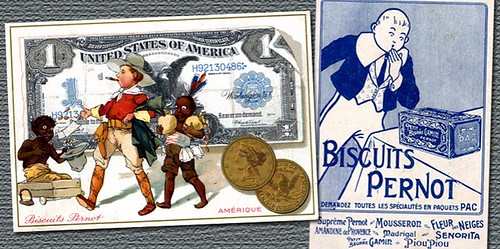
I recently added a neat French postcard to my exonumia collection simply because of the subject matter. The card is an advertisement for Biscuits Pernot, no doubt a popular snack in France in the late 1890s and early 1900s. The illustration on the front of the card, however, is what made me buy it. A trompe l'oeil Series 1899 $1 "Black Eagle" silver certificate forms the backdrop to what Frenchmen of the day no doubt thought of as a comical rendition of the American scene.
Front and center is a strutting young boy dressed as one of Teddy Roosevelt's Rough Riders in jodhpurs and knee-boots, cigar in mouth, wide-brimmed hat on head, and pistol by his side. His jacket is draped over his left arm and with his right hand he throws largesse in the form of gold coins and paper money at a young shirtless black boy in a cart with an andiron at its side, no doubt the poor beggar boy's method of locomotion. Walking along dutifully behind our American youth is another young black boy, this one dressed as a Native American with feathers in his hair and an American flag draped around his middle as a sash. The youth carries two large, swollen bags of gold coins, some of which are falling from a tear in one of the bags. In the lower right corner is the full-sized obverse and reverse of a gold-toned embossed U.S. half eagle dated 1886 with the word AMERIQUE beneath.
I can only guess that America was viewed by our French counterparts of the era as a land of adventurous, wealthy people who threw money at their problems and enjoyed the high life. As for me, I can't help but wonder if Biscuits Pernot were as good as the advertisement made them seem!
To read the complete article, see:
What the French Thought of Us at the Turn of the 20th
Century (www.stacksbowers.com/News/Pages/Blogs.aspx?ArticleID=2085)

U.S. POSTAL CURRENCY USED AS ACTUAL POSTAGE
The legislation calling for the creation of postage currency framed it as a special issue of stamps to be used as emergency substitutes for coins during the Civil War. Although they pictured U.S. postage stamps, they were ungummed and much more like paper money. Although I was unaware that any had ever actually served as postage, I guess I'm not surprised.
Paper Money editor Benny Bolin kindly forwarded me some text and images for this excerpt. Thanks! Please refer to the issue for the complete article. -Editor
In 1862, the US was faced with a severe coin shortage, as individuals were hording gold, silver and even copper coins during the country's dire economic condition. Several measures were attempted, but the best solution was the issuance of Postage Currency notes to replace scarce coinage. While Postage Currency was never meant to be used as postage stamps, some people who did not have a stamp handy used these notes as an emergency replacement. This did not occur very frequently since it cost only 2¢ to mail a letter and the smallest postage currency denomination was 5¢.
Instances of this usage are quite rare. Over the past 30 years, only a handful have surfaced at auction. The placement of Postage Currency notes on an envelope is eye-catching (especially to the fractional enthusiast), and when an example shows up at auction, it attracts a lot of attention.
There are no examples from the John Ford sales conducted by Stacks Auction, but from the CAA (Currency Auctions of America) Milt Friedberg sale in January 1997, three different examples were sold. Shown is the lot description and auction sale price.
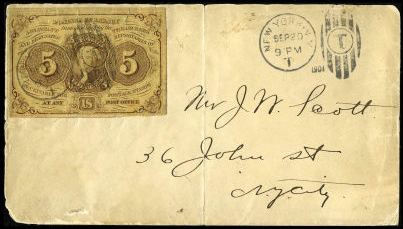
Lot 96. Postage Currency used as Postage. A 5¢ FR.1230 (Milton 1R5.4) mounted to the upper left of an envelope and postmarked “New York September 20 9PM 1901.” The identical postmark appears at the right of the envelope. One of the very few known indisputably genuine uses of postage currency as postage (750-UP). Purchased by Milt from Fractional Currency Inc in 1994 at the Memphis show. Sold for $770. This same example sold twice more both at exactly $2,300. At the Tom O'Mara HA sale in September 2005 and from the Peter Gamble collection auction by HA in January 2008.
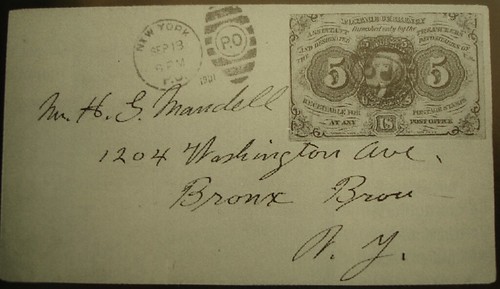
Lot 98. Postally Used Fractional Currency. A 5¢ First issue note has been used as a stamp to mail a letter which is postmarked September 18, 1901. Although not specifically authorized for use as postage, First issue notes occasionally, although rarely, were pressed into service as stamps. This five cent note on its plain cover appears to have been used as postage rather than a gimmick, souvenir or hobby stunt. (500-up). rom Abe Kosoff's 1971 sale of the Julian Marks Collection. Sold for $577.50.
For more information about the Society of Paper Money Collectors, see:
www.spmc.org
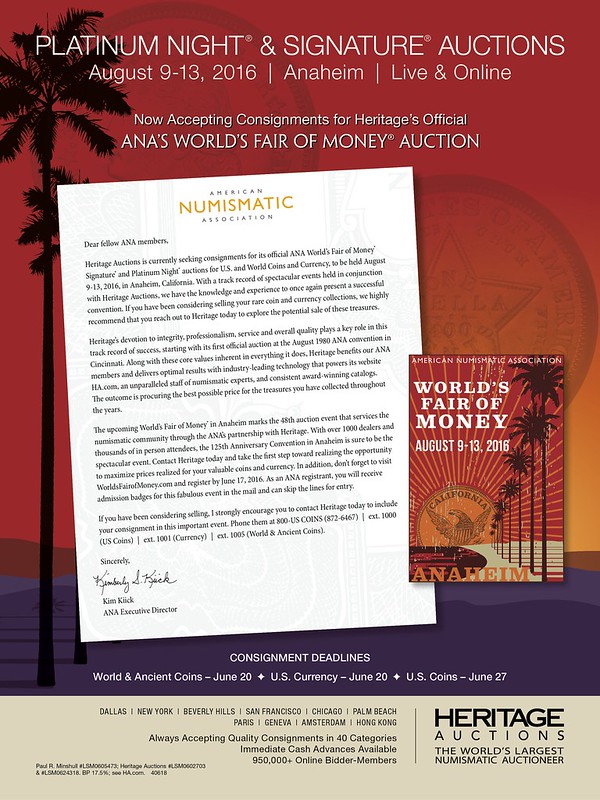
WAYNE'S NUMISMATIC DIARY: MAY 15, 2016
After work Tuesday May 10, 2016 I pointed my car toward downtown Alexandria, VA for the monthly meeting of Nummis Nova, my Northern Virginia numismatic social club. Aaron Packard was our host, and the venue was Southside 815 at 815 S. Washington street.
I was the first to arrive at about 5:30pm. As the staff set up our table Eric Schena arrived. We sat down and began chatting. I ordered a draft beer and showed Eric some new books I'd brought along.
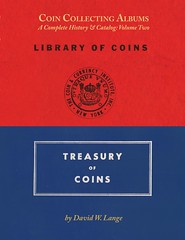
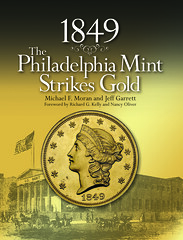
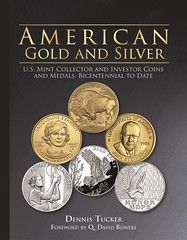
Regulars Julian Leidman, Joe Leidman and Gene Brandenburg were unable to make it. Seated across from me and Eric were Dave Schenkman and Jon Radel. To my right was Robert Hoppensteadt. Other attendees included Tom Kays, Joe Esposito, Lenny Goldberg, our host Aaron Packard, Steve Bishop, Mike Packard and Wayne Herndon.
My companions brought along a great range of interesting material for display, and they kindly shared images and descriptions. So I'm turning the rest of my diary over the them, the numismatic mavens of the evening.
Eric Schena: Bank of Virginia $50 Note
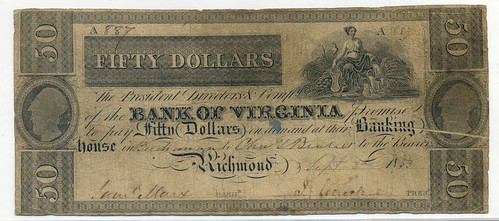
Eric's 1859 Bank of Virginia $50 note is a rare issued example of a higher-denomination note. Most genuine higher-denomination notes got redeemed, leaving for collectors only printer's proofs and counterfeits.
Eric adds:
The note I brought was issued by the Bank of Virginia's branch in Buchanan in Botetourt County just northwest of Roanoke. Some of the bigger Virginia banks had branch offices throughout the state, even though the notes themselves were numbered and signed at the "mother" bank. This note is interesting in that it has a printed fold plus was formerly in the John J. Ford, Jr. collection.
Jon Radel: Medals of the Guild of Medallic Art in Finland
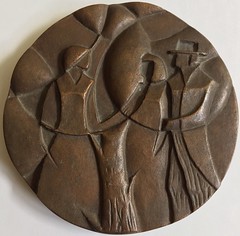
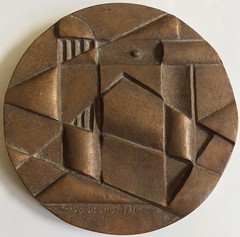
Juhlavuosi (Anniversary) by Toivo Pelkonen
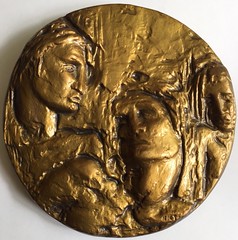
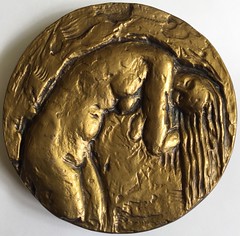
Elämää (Life) by Hannele Kylänpää
Jon writes:
I brought two medals from the annual series of the Suomen Mitalitaiteen Kilta – Gillet för Medaljkonst i Finland ( The Guild of Medallic Art in Finland) founded in 1965. The competitions also started in 1965, and given the prominence of the organization, for at least some of its history the patron was the president of Finland (I'm unclear on the current status), many prominent artists have participated.
The first medal is by Toivo Pelkonen, Juhlavuosi (Anniversary), the winner of the 1975 competition. 121 mm / 1070 g.
The second medal is by Hannele Kylänpää, Elämää (Life), the winner of the 1976 competition. 115 mm / 970 g.
The guild's old website is still up with a listing of all the winners through 2000 at http://www.kolumbus.fi/mitalitaide/yearmedals.html. More recent medals can be seen on their current website, though I find the photos less satisfactory, at http://mitalitaide.fi/?page_id=666. A good starting point for more information, particularly for those who don't read Finnish, is at http://mitalitaide.fi/?page_id=28.
Steve Bishop: Medals and An Overstruck 5 Kopecks
Steve has also become a fan of Finnish medals, and he brought some interesting examples.

Finnish Union of Veterans and War Invalids Medal
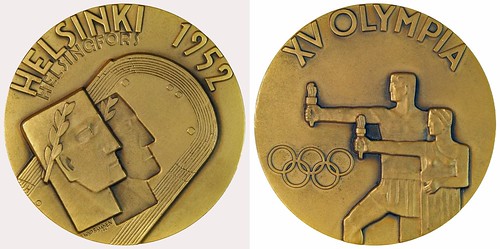
1952 Olympics Particpant Medal by Rasanen
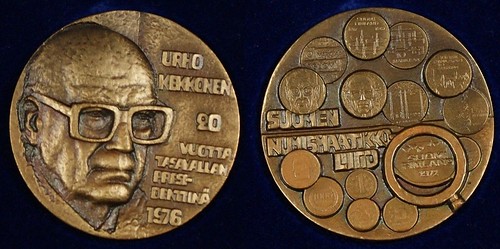
1976 Medal Showing Coins Issued Under Finnish President Urhu Kekkonen
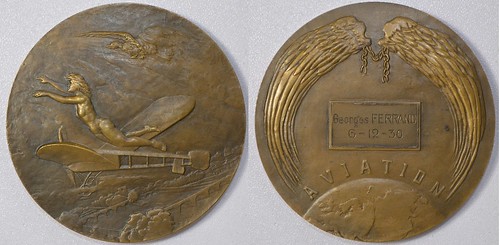
1930 French Aviation Medal to Georges Ferrand
I like these Art Deco era aviation medals. They're not all about Lindbergh.
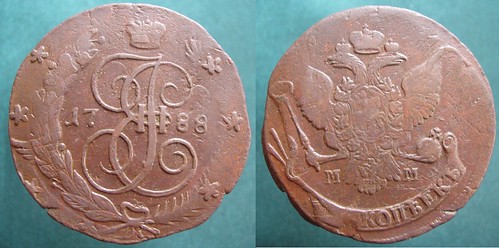
1788 MM 5 Kopecks Overstruck 2
Steve writes:
The 5 kopeck piece is a particularly nice example of the type (Catherine 5 kopeck struck over 1762 10 kopeck), because it shows so much of the under-coin.
Robert Hoppensteadt: Bronze coin from Caesarea ad Libanum in Phoenicia
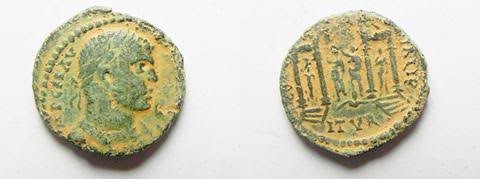
Robert writes:
My coin is a small 24mm bronze from Caesarea ad Libanum in Phoenicia. There are only a handful I could find in existence and this is the nicest one of the 8 or so that were located.
The obverse is a laureate bust of Severus Alexander, the reverse is a tetrastyle temple, in the center is a statue of Astarte being crowned by an unknown male figure in military garb (possible Severus) with a river god swimming at their feet, one other female statue stands in each wing with a stairs leading up to them.
Interesting architectural type, possibly minted in celebration of Severus Alexander's ascension to the throne as he was born in this town in 208. One source had enough of an obverse inscription to note this was struck for Severus as Caesar, which would have been over only a few days in March 11-14th (or until the town was informed of his being made emperor) - can't make that out on this piece as it would have been on the right side of his bust and the other known pieces are not readable either but given the rarity it is possible they were only struck for a very short time.
I too, like ancient coins featuring architecture, but have never collected them. Nice piece.
Joe Esposito: Upton Sinclair Satire Note
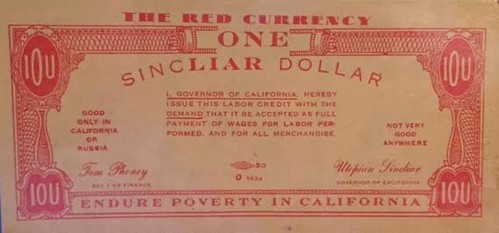

Joe writes:
Upton Sinclair (1878-1968) was a prolific novelist, but was best known for books which called attention to the power of big business and the plight of the common worker in the early twentieth century. Perhaps his most notable book was The Jungle, about the Chicago meatpacking industry. He also was politically active as a socialist and Democrat in California in the 1920s and 1930s.
Sinclair was the Democratic nominee for governor of California in 1934, promoting a program he called End Poverty in California (EPIC). He was defeated at least in part because of his socialist agenda. Among the attacks on him was the “SINCLIAR DOLLAR.”
Some amusing aspects:
1. It is printed in red and identified as “The Red Currency,” referring to the Soviet Union and communism.
2. It is “signed by” Utopian Sinclair,” and “Tom Phoney.”
3. Because his running mate was Sheridan Downey, the currency was “issued” by “Uppy” (Sinclair) and “Downy.”
4. It states that it is “Redeemable if ever at the cost of future generations.”
5. The money was “good only in California or Russia,” but “not very good anywhere.”
Tom Kays: Washington Medal

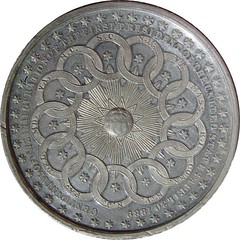
Tom writes:
The Washingtonia piece I brought is a Douglas 52-a from the Centennial of George Washington's “First” Inauguration, celebrated in 1889. From Joe Esposito's forthcoming article in the Spring 2016 edition of The Virginia Numismatist we know it is: “… a work from dies originally done by Charles Cushing Wright (1796-1854)…The obverse reflects the bust done of Washington by Jean-Antoine Houdon in the late 1780s or 1790s. The portrait is also the basis for the current Washington quarter by John Flanagan. But the real beauty of this 54-mm medal is the reverse. Here there are thirteen interlocking state rings, signifying the unity of the new nation in 1789. In the middle is a radiating sun. The design is a more elaborate rendering of the reverse of the Fugio Cent, which states in the center: “WE ARE ONE.” This medal is known as “Thirteen Links.”
It is interesting that the medal has forty-two stars on the obverse while the Saint-Gaudens has thirty-eight. The reason is that four states—North Dakota, South Dakota, Montana and Washington—were added to the Union in November 1889. Saint-Gaudens' work preceded the Wright/Chapman medal.” Thanks to Joe Esposito for this description.
And More...
Tom Kays supplied these images of other items that graced our table.
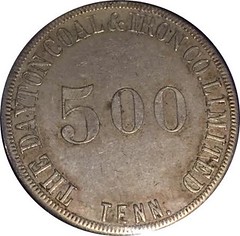

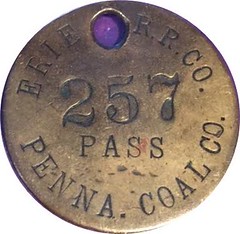
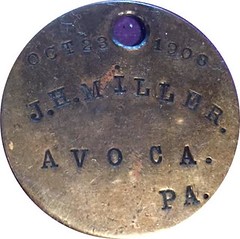
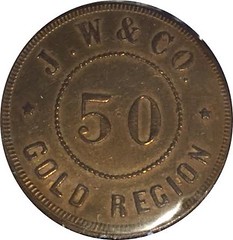
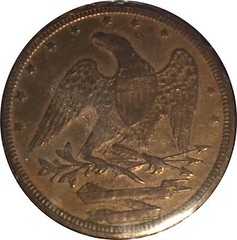
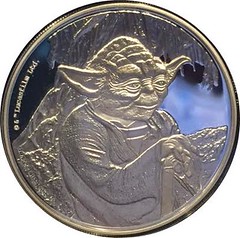
Tom adds:
I sat by Wayne Herndon who told me his mass marketing strategy for much of the evening which was an eye-opener about the business that happens over coin show tables, behind the table at coin shows, after the show, and on the Internet where much of the profits really come in.
Dealing in hobby supplies is a lot different than dealing in coins. Wayne drives a truck and trailer to shows sometimes with 12 tons of Wizard coin supplies. He may come home with 11 tons after a good show but with dealer business cards listing item volume amounts for direct shipping of tons more supplies the next week from the vast Wizard Coin Supply warehouse. With over 100,000 different Internet purchasers, many beyond the numismatic hobby, his is an entrepreneurial niche on a scale we can only guess.
My beer got warm before I finished it. I switched to soft drinks. Dinner was good. I visited with Tom Kays, Joe Esposito and Wayne Herndon before heading home around 9 o'clock. As always, it was a fun night of numismatic fellowship. Looking forward to next time!

COINWEEK'S MORGAN ADDRESSES 29TH MINT DIRECTORS CONFERENCE
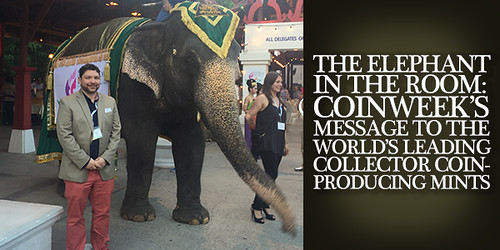
I've been home about a week from my trip to Thailand where CoinWeek was invited to be a presenter at the XXIX World Mint Director's Conference. I have to say that the Royal Thai Mint did a fantastic job hosting the event in the heart of Bangkok, a world-class city almost indescribable in the sheer scale of its towering skyscrapers and busy streets teeming with people, cars, and motorbikes. Thailand is known to many as the “Land of Smiles”, and those in attendance–mostly mint directors and key personnel from leading state and private mints from around the world–were treated to some of the friendliest people and amazing food that I've ever had the pleasure to experience.
And I'd be remiss if I didn't mention the fantastic cultural exchange, including a visit from Her Royal Highness Princess Shrindihorn.
But beyond the pomp and circumstance, the reason for the gathering was to share information and expertise, and to find common ground for the sake of preserving and growing the coin minting industry.
I traveled to Bangkok to present a case for the commemorative and NIFC (Not Intended for Circulation) coin-issuing mints to consider the challenges of maintaining a secondary market for their products.
One need not be a professional coin market analyst to understand that the rare coin industry is mostly built on the recycling of a finite inventory of coins from the past. The mints, of course, contribute to this inventory, but in this postmodern era of coinage they produce far too many coins and offer them at too high a cost to insure that these coins will maintain their price in the long run.
We know all too well that many modern issues, even those that are popular out of the gates, do not fare well in the secondary market in the long term. Combating this problem won't be easy, but we think that the mints have a role in the matter and do bear some of the responsibility for the product they create.
In essence, the issue comes down to market sustainability and branding. No coin collector buys a coin with the intent of throwing it away when they grow tired of it. The cold hard truth of the collector coin market is that we're all just temporary owners of the coins we buy. And while the U.S. market is more investor-oriented than any other coin market in the world, it makes sense for the industry to research and develop ways of either capitalizing the secondary market for their past issues (when there's a need) or means of sustaining interest in past product so tomorrow's collector will find today's modern issues as interesting as we do.
As daunting as it might seem to stand up in front of representatives of all of the world's major mints to deliver this message, I found strength of purpose from my belief that sustaining the collector market in the long term is in the minting industry's best interests. Especially at a time when the very physical reality of money is increasingly challenged by digital forms of payment, aka the dreaded “cashless society”.
Also, by carrying this message, we represent the interests of their customers–you, our CoinWeek readers. In making light of the collectors' impulse to turn a profit from a coin purchase, I told the mint directors that “inside the heart of every collector is a greedy little speculator”. In actuality, I don't think any of us expects every coin we ever buy to pony up the goods, but we do hope that if we spend $100 of our hard-earned cash for a beautiful modern collector coin that we won't be left totally upside down, having nothing more to show for it than a fancy piece of bullion.
The coin market has already lived through the collapse of that system when the bottom fell out of the Franklin Mint's much-hyped marketing plan back in the 1970's. We certainly don't want a repeat of that, when the mints need collector support more than ever.
To read the complete article, see:
Editor's
Note – World Mint Directors' Conference XXIX: A Time for Cooperation
(www.coinweek.com/world-mints/world-mint-news/editors-note-world-mint-directors-conference-xxix-time-cooperation/)
To read the earlier E-Sylum article, see:
THE 29TH MINT DIRECTORS CONFERENCE
(www.coinbooks.org/esylum_v19n13a18.html)
NRA VICE PRESIDENT SIGNS AMERICAN EAGLE HOLDERS
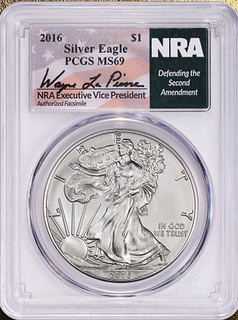 NRA Executive Vice President Wayne LaPierre is joining the ranks of several former U.S. presidents and more than 40 members of the Baseball
Hall of Fame in teaming up with 1st American Reserve to provide signature backing for a limited-edition silver dollar.
NRA Executive Vice President Wayne LaPierre is joining the ranks of several former U.S. presidents and more than 40 members of the Baseball
Hall of Fame in teaming up with 1st American Reserve to provide signature backing for a limited-edition silver dollar.
The American Eagle silver coin comes in a protective case and includes a reproduction of LaPierre's signature on the label. The 2016-dated coin is graded Mint State 69 on the 70-point numismatic grading scale. Each coin contains one ounce of 99.9-percent pure fine silver, and the grade has been certified by the Professional Coin Grading Service, according to Michael Fuljenz, chief numismatic consultant for 1st American Reserve.
Previous editions of such coins have come with signatures of former U.S. presidents, top-level athletes and other notable individuals.
The release is part of a fundraising effort as the NRA gears up for this year's critical election. For each coin sold, 1st American Reserve will donate $2 to the NRA to help the Association work to preserve our Second Amendment-protected right to keep and bear arms.
The price per coin, subject to change based on the spot price of silver, is $26.99, plus shipping.
To read the complete article, see:
Wayne LaPierre
Signature Coin To Raise Money For NRA
(www.americas1stfreedom.org/articles/2016/5/13/wayne-lapierre-signature-coin-to-raise-money-for-nra/)
THE BOOK BAZARRE
OFF-METAL ERROR TWO PENCE FOUND IN CHARITY BUCKET
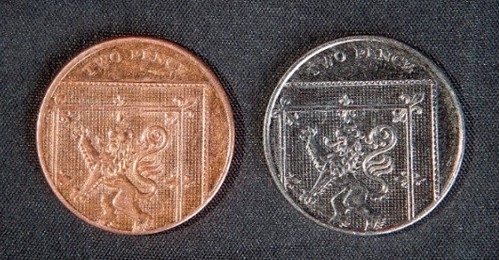
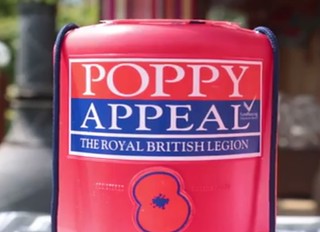 Poppy collectors were stunned after discovering an extremely rare SILVER 2P coin in a tin - one of the only in the world and worth up to
£2,000.
Poppy collectors were stunned after discovering an extremely rare SILVER 2P coin in a tin - one of the only in the world and worth up to
£2,000.
The almost unique coin was donated to a branch of the Royal British Legion as they were collecting in the street. They found the ultra rare 2p in amongst the normal coppers and pounds - and handed it to the bank to be destroyed thinking it was a fake. But The Royal Mint confirmed it was the result of a ‘minting error' when a blank 10p was accidentally put in a 2p mint.
To read the complete article, see:
http://www.yorkshireeveningpost.co.uk/news/offbeat/video-rare-silver-two-pence-is-found-in-poppy-collection-1-7901205
(www.yorkshireeveningpost.co.uk/news/offbeat/video-rare-silver-two-pence-is-found-in-poppy-collection-1-7901205)
BLACK MARKET PRICE OF €500 NOTE COULD RISE
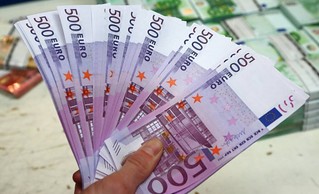 As the European Central Bank stops printing new €500 notes, the value of these big bills could climb as people pay more to own them.
As the European Central Bank stops printing new €500 notes, the value of these big bills could climb as people pay more to own them.
The ECB said on Wednesday that it will stop printing a note that police agencies say is a preferred tool for international criminals.
But like pop stars and painters, the value of these notes may increase in death.
Some of the ECB's senior policymakers didn't like the idea of getting rid of the note entirely. So while new €500 notes won't be printed any more, they will remain legal tender.
Typically, when a central bank stops producing a denomination or a series of banknotes, it offers a fixed period in which it will still be accepted as legitimate currency.
For example, a British £20 note bearing the image of Edward Elgar was issued from 1999, ceased production in 2007 and stopped being legal tender in 2010. In the eurozone, national central banks will still exchange their old currencies, from the franc to guilder, for euros. But they can no longer legally be used purchase goods and services.
Restricting the supply of the €500 note could actually result in this note, one of the largest in major economies, trading at a premium to other euro denominations. Even before the decision, there were reports that this was happening.
In 2015, Europe's umbrella organization for policing, Europol, warned that law enforcement agents had informed them that €500 notes trade hands at above their face value in the criminal world, “so important is their role in cash transportation for money laundering.”
And that phenomenon is not unique to Europe.
The highest U.S. dollar denomination, the $100 bill, trades at a significant premium in many emerging markets. That's according to Peter Sands, the former CEO of Standard Charted who sparked the discussion over high denomination banknotes earlier this year.
Argentina, Ethiopia, Indonesia and India are among the countries where buyers will stump up more of their local currency to get hold of $100 notes, paying between 2% and 20% more for the highest denomination, Mr. Sands said.
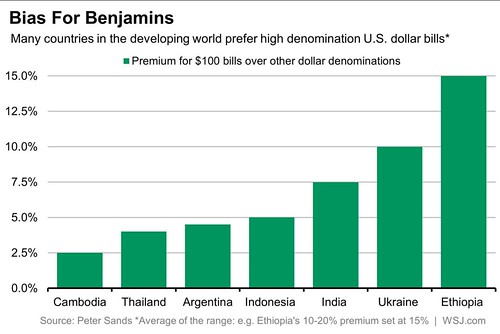
Though the idea seems odd, history shows that notes of the same ostensible value can trade at a premium to others.
Before the U.S. National Bank Act in 1863, many U.S. dollar notes were issued by private banks. The notes were traded at values based on how creditworthy the bank was regarded.
In much of the country, and particularly during banking panics, that made some dollars worth more than others.
Congrats to the WSJ for noting the historical range of values for circulating banknotes in the U.S. -Editor
To read the complete article, see:
(http://blogs.wsj.com/moneybeat/2016/05/06/the-death-of-the-e500-note-could-boost-its-black-market-price/) The Death of the €500 Note Could
Boost its Black Market Price
To read the earlier E-Sylum article, see:
EUROPE TO DISCONTINUE 500-EURO BILL
(www.coinbooks.org/esylum_v19n19a29.html)
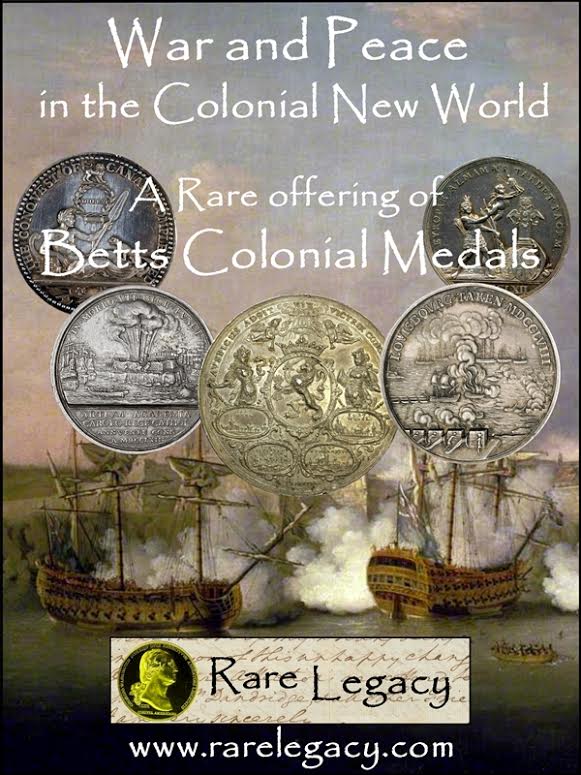
DISNEY BUSTED IN MASSIVE COUNTERFEIT SCHEME

In a move that sent shockwaves through the amusement park community, Disney World and Disneyland have been busted for running one of the most elaborate and widespread counterfeit money schemes in history. According to a report from Robot 6, Disney parks have been producing fake currency featuring Disney characters since 1985 in denominations of $1, $5, $10, $20 and $50, and have somehow managed to fly under the radar of authorities for all of that time.
However, a recent sting operation that involved FBI agents dressed as costumed characters revealed that the counterfeit bills were in circulation all over both American Disney parks, with vendors exchanging the bills for real American currency. Government forces moved swiftly to shut down the operation, seizing over 2 billion Disney dollars in fake currency, as well as an entire money vault full of the stuff owned by powerful Disney executive Scrooge McDuck.
At press time, authorities believed it could take years before all of the Disney Dollars could be taken out of circulation. No arrests have been made at this time, but the hideout of local criminal organization The Beagle Boys is reportedly under surveillance, and police and swat teams could move in at any moment. We'll keep you posted.
To read the complete article, see:
REPORT: DISNEY BUSTED
IN MASSIVE COUNTERFEIT SCHEME (www.theouthousers.com/index.php/news/135321-report-disney-busted-in-massive-counterfeit-scheme.html)
FEATURED WEB PAGE: PALESTINE MANDATE COINS
This week's Featured Web Page is devoted to the B'Nai B'Rith Internations collection of Palestine Mandate Coins.Shortly after World War I, Britain took control of an area known as the Palestine Mandate. The region, which was created out of land formerly controlled by the Ottoman Empire, consisted of the territory we know of today as the nation of Israel, the Palestinian Administrations in the West Bank and Gaza Strip, and the Hashemite Kingdom of Jordan. To effectively administer this area, a stable monetary system was required. As a result, a unique numismatic event took place, one that will never occur again. The British Palestine Mandate coins were minted. These were the only coins that were ever minted with the word "Palestine" inscribed on them. Under the aegis of the British Mandate, coins were minted from 1927 to 1946. Coins dated 1947 were minted, but not distributed. The entire 1947 issue was supposedly melted down, however a few managed to survive. Today, the few remaining 1947 Mandate coins represent some of the rarest coins in the world.
What makes these coins very special is that they were they only coins in history that were minted with the name of a sovereign country that never existed: Palestine. The complete set consists of 59 different coins that range from 1 Mil to 100 Mils. Today, to accumulate a complete set is a very difficult and challenging assignment.
The B'nai B'rith International Center for Jewish Culture, located in Washington, DC, was fortunate to receive a donation of a complete set of these historic coins. In addition to this virtual coin museum, the coins are on display at the Center.
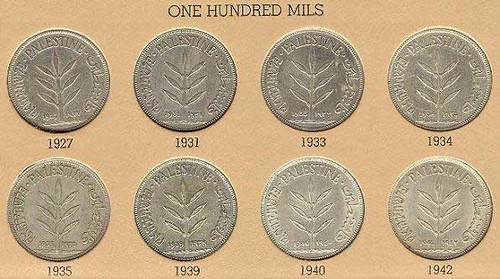
www.bnaibrith.org/palestine-mandate-coins.html

